Since our inception, we’ve given rundowns on many electric vehicles (EVs) — cars, RVs, trucks, and boats. It’s hard to believe how many more advancements have been made since 2020. There have been hiccups along the way, but EVs are becoming more popular every year. We got it all, from name brands to niche manufacturers in this listicle. We’ve split them into luxury, mid-range, economy, and hauling/municipal for easy reading.
Luxury

Photo Courtesy Audi
Audi e-tron: Audi’s e-tron is capable of competing with Tesla and Jaguar in the luxury e-SUV market. Using the build of a Q8 maximizes what worked with internal combustion models, with subtle tweaks to the body to make sure electrical performance is up to par.
It’s a very tech-savvy vehicle. Three different screens make up the infotainment system. There’s plenty of cargo room, up to 29 cubic feet of storage space. The range is 222 miles per charge, with 218 miles in the e-tron Sportback hatchback.
A regenerative braking system restores charge to the battery. Its fast-charging capabilities allow it to go from 10 to 80% in 30 minutes. The dual-motor all-wheel drive (AWD) engine offers 355 horsepower and reaches 402 horsepower in sport mode. An S model uses 469 power and goes 0-to-60 in 4.3 seconds, compared to the 5.1 seconds in the standard e-tron.
The MSRP starts at $67,095, with the Sportback costing $70,295. Audi hopes this car will spearhead its electrification initiative. The company plans to halt the development of internal combustion cars in 2026 and will be all-electric by 2030.
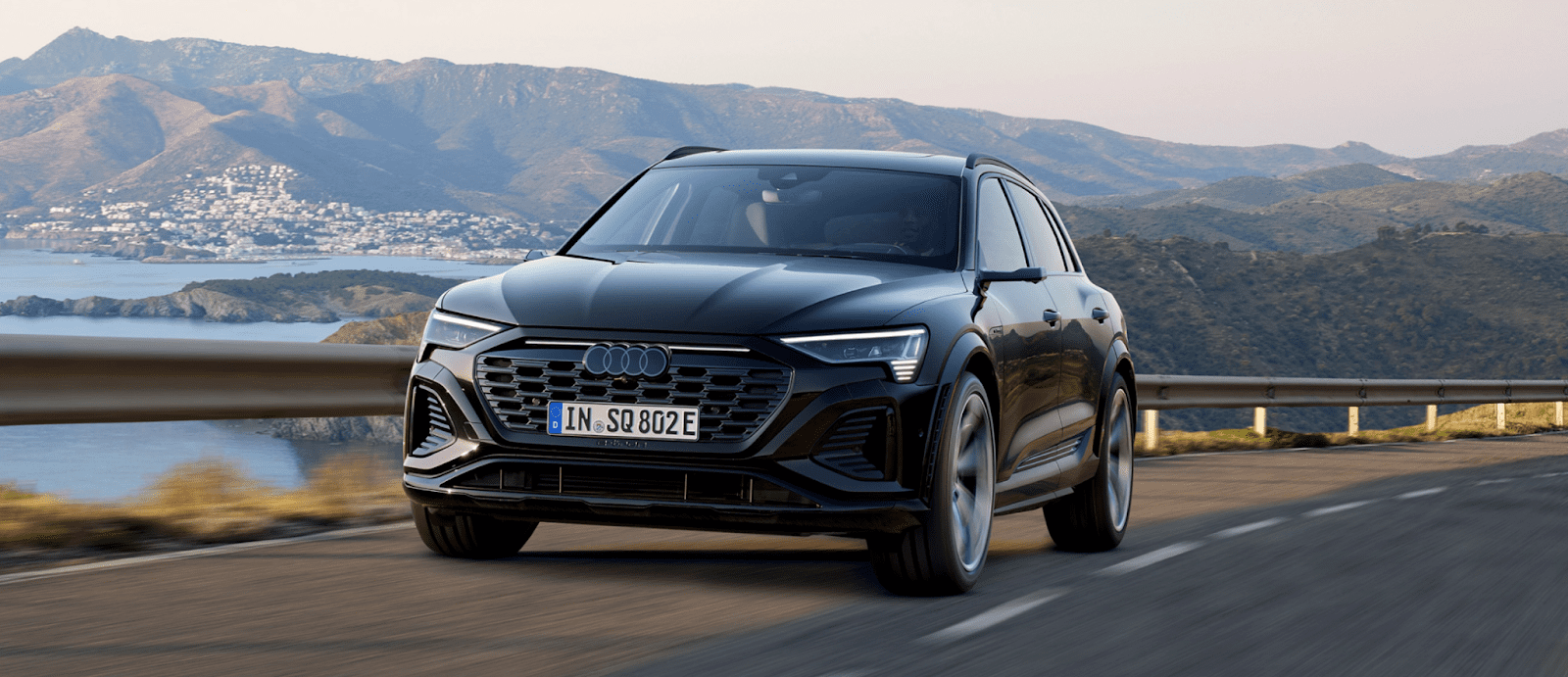
Photo Courtesy Audi
Audi SQ8 E-Tron: Audi’s SQ8 e-tron is challenging to categorize at first glance. Is it a “Sportback” small-size SUV, a crossover, or a full-size hatchback? However, under the hood is less confusing, with the German automaker saying the SQ8 will be a high-performance small SUV.
Around 496 horsepower makes up the new car’s motor. When it comes to charging, a 106-kW battery is powering the drivetrain. Audi says fast charging can get the battery from 10% to 80% in just 31 minutes. “Car and Driver” also say it will have around 73 mpge in the city and 78 mpge on the highway.
The myAudi app can track charge rates, notifying drivers about charge times and routes to find charging stations.
The inside comes standard with Audi’s modern infotainment system, a heads-up display, a digital dashboard with GPS capabilities, leather upholstery, a panoramic sunroof, automatic climate control, and heated seats. Drivers can control the car’s music and climate in the myAudi app.
The estimated pricing for the base model ranges from around $91,000 to $98,000. The 2023 model is available now, and the 2024 model arrived in April. It should be available for purchase in September 2023.
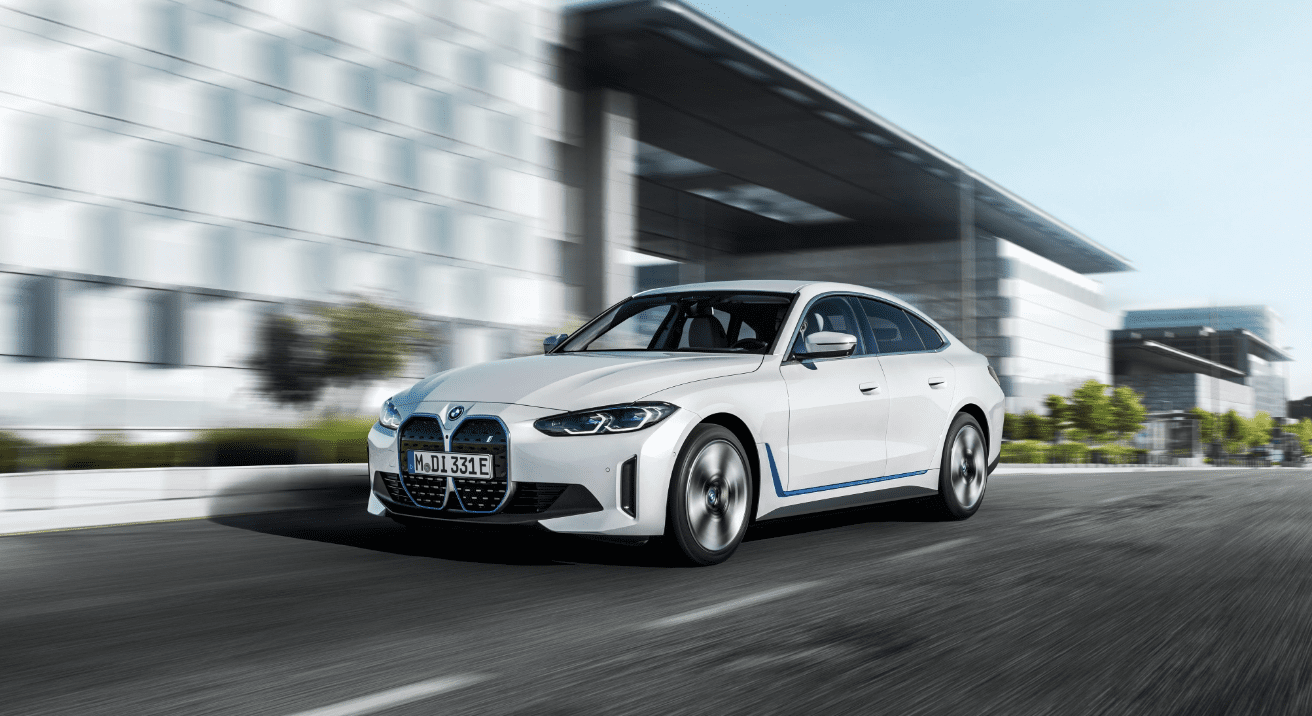
Photo Courtesy BMW Group
BMW i4 eDrive35: Electric cars are expensive commodities. Some of the niche brands can run well over the $100,000 mark. BMW has recognized that for widespread EV adoption, prices have to be reasonable. That’s where the BMW i4 eDrive 35 comes in.
This scaled-down sedan costs under $50,000 MSRP. It boasts a respectable 281 horsepower and 260 miles of range before the next charge. Inside, there’s a 12.3-inch touchscreen infotainment system.
The charge rate is decent, too, with only 32 minutes needed to go from 10% to 80% fully charged. It’s not the fastest electric sedan, only going from 0-to-60 in 5.8 seconds, slower than the M50 and eDrive40 counterparts. However, the goal of eDrive35 is to offer a luxury electric car that doesn’t break the bank and is reliable.

Photo Courtesy BMW
BMW X5: One of three plug-in hybrid options offered by the German automaker, the X5 is a rather powerful SUV. Under the hood, six cylinders in a combustion motor backed up by an electric one combine to create 389 horsepower. It can reach 0-to-60 in 5.3 seconds — pretty fast for an SUV. The e-MPG is commendable, getting 31 miles of electric range.
If electric power isn’t enough, gas power takes over. A regenerative braking system restores charge to the batteries without a charging station. The gas power doesn’t really kick in until the X5 reaches 84 mph. The downside is that the motor only has 111 horsepower, so reaching that speed can take some time.
In the cabin, the digital dashboard lays out all the car’s performance information, like hybrid range, gas use, electric output, and charge status. This car starts at $63,700 MSRP but is eligible for the $7,500 clean vehicle tax break.

Photo Courtesy BMW
BMW i4: The predecessor to the i4 eDrive35, the original BMW i4 is the last electric model to use the CLAR modular platform. The car will use the Neue Klasse (New Class) modular system going forward. This change is expected in 2025, with all BMW electric powertrains running on it.
The current i4 has all-wheel drive and delivers 335 horsepower and 319 pounds per foot of torque. There’s also a faster model: the i4 M50, based on the racing-standard M50 coupe. Tracking testing found that it goes from 0-to-60 in 3.9 seconds. Publications like MotorTrend and Car and Driver found even faster driving times.
The i4 offers plenty of range, up to 300 miles before the next charge; the M50 model has 275 miles. Charging is faster than other EVs — 88 to 108 miles of range can be returned in just 10 minutes of charge.
The dashboard comes with one of the best infotainment systems in the world. It shows integral information like GPS, speed, road signs, and phone integration. The MSRP starts at $56,395.

Photo Courtesy BMW
BMW iX: In 2021, BMW released the iX model, its first-ever electric hatchback the German auto giant produced. Complete with a dual-motor AWD powertrain, the car comes with 512 horsepower. It goes 0-to-60 in 4.4 seconds, fast for a crossover.
A performance version of this car, the iX M60, has even more horsepower with 600 and a sub-four-second 0-to-60 time.
Battery range is about 315 miles, and Level 3 charging capabilities allow it to charge to 80% in just 35 minutes.
The interior is unique, with the steering wheel’s hexagonal shape for ergonomic support. The heads-up display shows features like map directions, battery charge, and mileage. The panoramic roof lets in plenty of natural light and can be shaded with a push of a button. There are multiple safety features like a rear-view camera, lane departure alerts, blind spot detection, etc. The iX starts at $84,195.
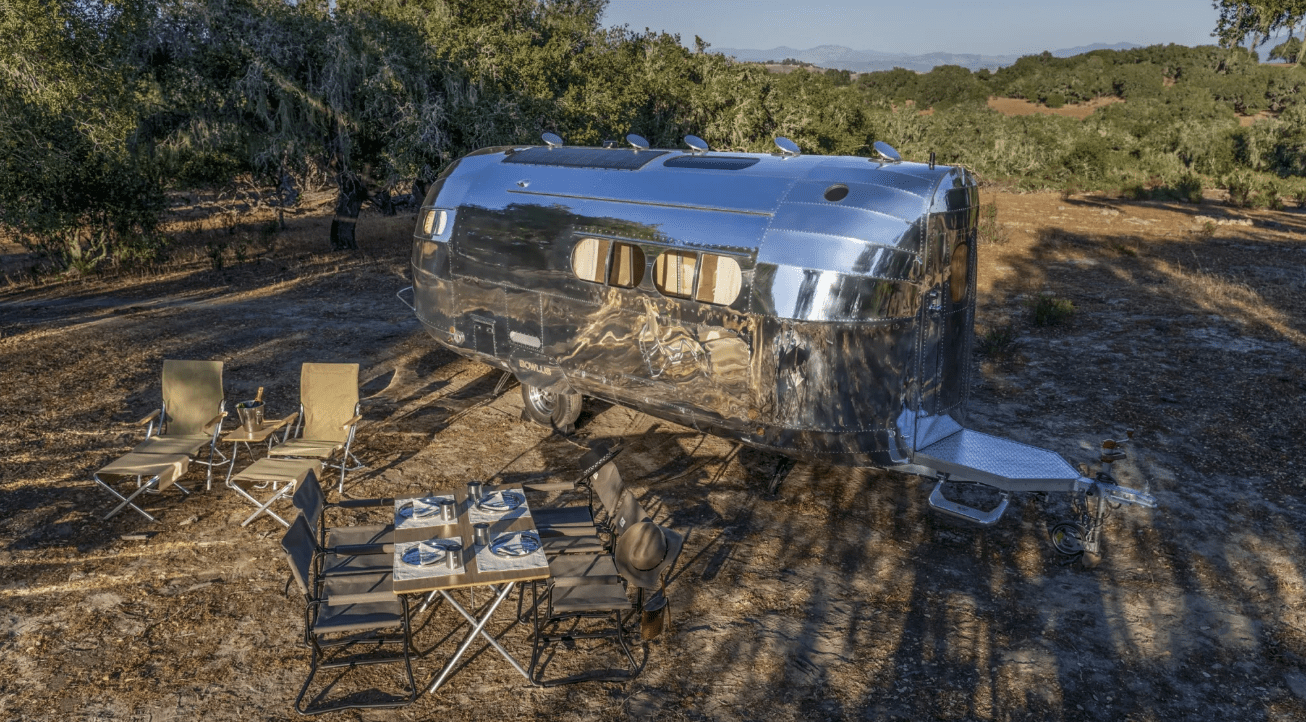
Photo Courtesy Bowlus
Bowlus Volterra EV RV: One of the coolest attachments for an EV, the Bowlus Volterra RV revolutionizes the camping experience. The camper trailer is modeled after the classic Airstream from the 1970s.
It comes equipped with a kitchen, shower, and full beds. The Volterra has solar panels built into the roof to charge it while parked at the campsite, which can power the interior’s features. The whole RV takes about 46 hours to charge to full battery. It can even be used as an emergency charger for your EV. It gives the car 60 miles of range back.
Inside, it’s like a mobile apartment. The kitchen has an induction stove, an electric stove that doesn’t overheat, a convertible king bed, a large bathroom, and a heated shower. The niftiest feature of the Volterra is the Starlink satellite internet. Travelers won’t have to worry about getting lost or contacting people in case of emergencies.
It’s a pretty expensive camper starting at $310,000. It’s still a very luxurious way to camp.
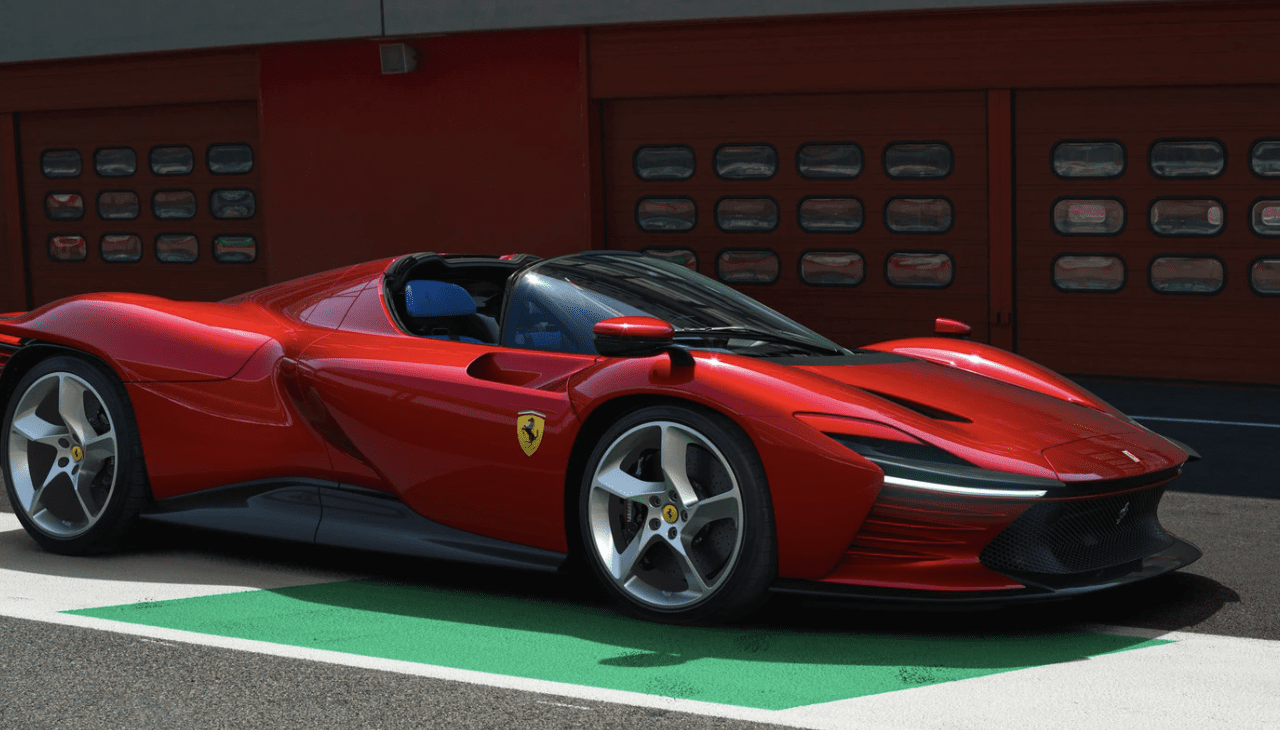
Photo Courtesy Ferrari
Ferrari SF90 Stradale: As Ferrari prepares for broader electrification, the company has put the plug-in hybrid SF90 Strasdale on display as the start of better things to come. CEO Benedetto Vigna says he plans to roll out a fully-electric car by 2025 and open eco-friendly factories.
For now, the Stradale will be the only car with some electric power in the engine. It’s a crazy fast hybrid car with 986 horsepower under the hood. It goes 0-to-60 in 2.0 seconds and gets 51 mpge along with 18 mpg from gas power alone.
Once Ferrari’s E-Building begins producing EV components, the electrification at Ferrari will keep tremendous.
The company predicts 40% of its production will be electric-only cars. In addition, 80% of Ferrari’s lineup will be electrified by 2030.
Thanks to Vigna’s background in the semiconductor industry, he brings fresh knowledge of some of the most important aspects of electric cars. That will only spur more EV production.

Photo Courtesy GMC
GMC Hummer EV: Since the Hummer brand was scrapped in 2010, we thought we’d never see the bruising behemoth vehicle ever again. That was until 2020, when General Motor Company (GMC) announced the revival of the truck, this time with electric power.
It’s one of the craziest electric trucks ever produced. The front grille has ultra-bright LED lights with a moon-rover body. The hefty truck weighs in at 9,000 pounds yet is pacey and agile.
It can go 0-to-60 in 3 seconds, thanks to three electric motors under the hood. That gives the Hummer close to 1,000 hp and 350 miles of range. It can get 100 miles of range back with ten minutes of fast charging. GM’s Ultium batteries are powering this beast of a truck. That’s better than the Tesla Model X. The truckbed has a 1,300-pound payload and can tow anything up to 7,500 pounds.
The Hummer is equipped to handle the toughest terrain. Four driving modes can adjust suspension, steering feel, and drive height. The nifty “Crab Walk” feature allows for driving diagonally if you need or want to.
The interior is super spacious, with plenty of legroom in the back seats. A digital dashboard and medial control center make up the front. It’s a bit pricey, starting at $112,395 for the Edition 1 model, but there are smaller models comping that will be cheaper. Expect those smaller models to be released in 2024.

Photo Courtesy Jaguar
Jaguar I-Pace: The I-Pace is the first EV manufactured by Jaguar Land Rover. The electric crossover, launched in 2019, brought a fresh, exciting car to Jaguar’s lineup.
Unlike other crossovers, the I-Pace is less of an awkward fusion between SUV and sedan. It’s more like a totally bespoke vehicle. The door handles are flush with the doors, and its curved chassis increases aerodynamic performance.
Under the hood, the engine is no joke. It exerts 394 horsepower with 512 pounds-feet of torque. I-Pace’s acceleration goes 0-to-60 in 4.5 seconds, and it can drive for 253 miles on a single charge, competing with EVs from Audi and Tesla.
The battery can reach 80% charge in 40 minutes. The regenerative braking system chargings return charge to the battery.
The interior can seat five passengers and comes standard with a dual-screen control center. The safety systems are impeccable, too. Driver assistance features like emergency braking, adaptive cruise control, and blind-spot detection are just a few examples.
The current price sits at $69,200. The I-Pace is just the beginning of Jaguar’s electric fleet. The company plans to launch an expanded EV lineup in 2025.

Photo Courtesy Jetson Aero
Jetson One eVTOL: Swedish VTOL startup Jetson Aero has been working on a single-seater flying car. This vehicle is a drone-esque aircraft that can fly up to 60 mph. It also has an eight-rotor system that gives users better control of a small plane or helicopter.
The Jetson One is still a few years away from commercial sales. The battery range still needs to be sorted out. It only has a 20-minute charge life at the time of writing. Jetson also has to deal with regulators, as the One isn’t legal to fly in densely populated areas.
The company isn’t surprised, though, because flying cars are very much an untested technology. They’re designed more for fun than commuting or travel. Jetson ensured customers at least had or could obtain a legal pilot’s license before they considered making any sales.
In 2022, the first batch of One eVTOL orders came in, and deliveries for 2023 are expected soon.

Photo Courtesy Jaguar Land Rover
JLR EVs Get Performance, Range Boost: Jaguar Land Rover (JLR) inked a nifty deal with North Carolina-based semiconductor producer Wolfspeed. It will see racing tech used in Jaguar’s Formula E racing cars implemented in civilian EVs.
Wolfspeed has been a partner with JLR since 2017, helping Team Jaguar obtain or, at the very least, compete for Formula E glory on a few occasions. The deal was signed on Oct. 31, 2022. The Silicon Carbide technology will make JLR’s EVs more efficient and increase the range.
The first vehicle slated to use this technology will be the 2024 electric Range Rover and the new line of Jaguar EVs coming in 2025. Wolfspeed is producing these powertrains at a plant in upstate New York, the world’s largest 200-mm Silicon Carbide fabrication factory.
This effort is part of JLR’s greater electrification strategy, called Reimagine. The goal is to have electric-only sales, carbon-neutral supply chains, and eco-friendly operations by 2039.
Despite a few canceled projects like the XJ sedan, the future is bright for JLR’s EV lineup. There are even plans for hydrogen-powered Land Rover SUVs.
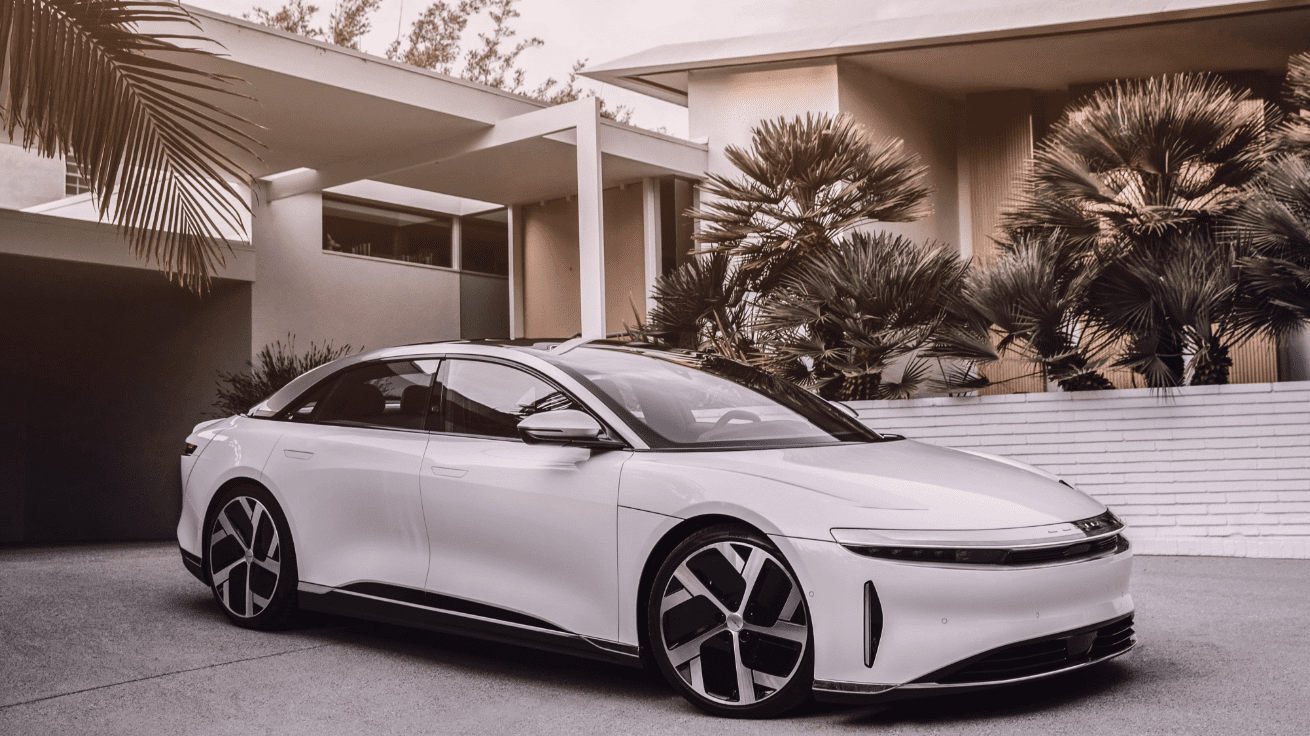
Photo Courtesy Lucid
Lucid Air Dream: In November 2021, the Lucid Air Dream won MotorTrend’s Car of the Year 2022, and this was the company’s first production release. Run by former Tesla chief engineer Peter Rawlinson, Lucid has been giving Porsche and Tesla a run for the money.
The Air Dream is an ultra-advanced electric car, complete with 1,111 hp in the engine and 0-to-60 in 2.5 seconds. It can hit a top speed of 168 mph — not bad for a civilian EV. Using the same batteries found in Formula E racecars, the Air Dream gets 520 miles of range before the next charge.
The sporty exterior is designed to look flashy without going over the top. Its curved design makes it one of the most aerodynamic EVs on the market.
Inside, the interior is elegant and spacious. The central control system has a touchscreen infotainment system and a digital dashboard. The interior is made from sustainable materials like Napa or PurLuxe vegan leather. The headliners are made from textiles like alpaca fur, recycled yarn, and Eucalyptus wood. There’s a front and back trunk for ample storage space.
The Air Dream requires yearly maintenance, but Lucid’s over-the-air operating system can update the car and run diagnostics through the cloud. The car is expensive, starting at $117,000.

Photo Courtesy Lucid Motors
Lucid Air Grand Touring: The Lucid Air Grand Touring could give Tesla a run for the money. Testing by “Car and Driver” found that it was faster and more efficient than the Tesla Model S. The Air can reach a battery range of 410 miles, a new record for an EV. It’s 90 miles more than the Tesla Model S’s battery.
The aerodynamic design of the Air allows it to cruise longer with less drag to fight. The luxury sedan can go 0-to-60 in 3 seconds, just under the Model S’s time of 2.7 seconds. Testing also found the Air Grand Touring and Air Touring models had better-charging rates than Tesla. The car can go from 10% to 90% in 46 minutes, returning 297 kilowatts at peak charge, higher than Tesla’s 250 kWh.
Lucid owners can get up to three years of complimentary charging with a purchase of an Air. The car has bidirectional chargers for home-charing, and if home power is lost, the Air can power it with its battery.
The interior is stylish, with wireless phone chargers built into the cup holders. It has a very advanced infotainment system with features like GPS, Bluetooth media and phone integration, and music streaming apps. The car is quite pricey at $155,600 for the Grand Touring model and $140,500 for the base Touring.
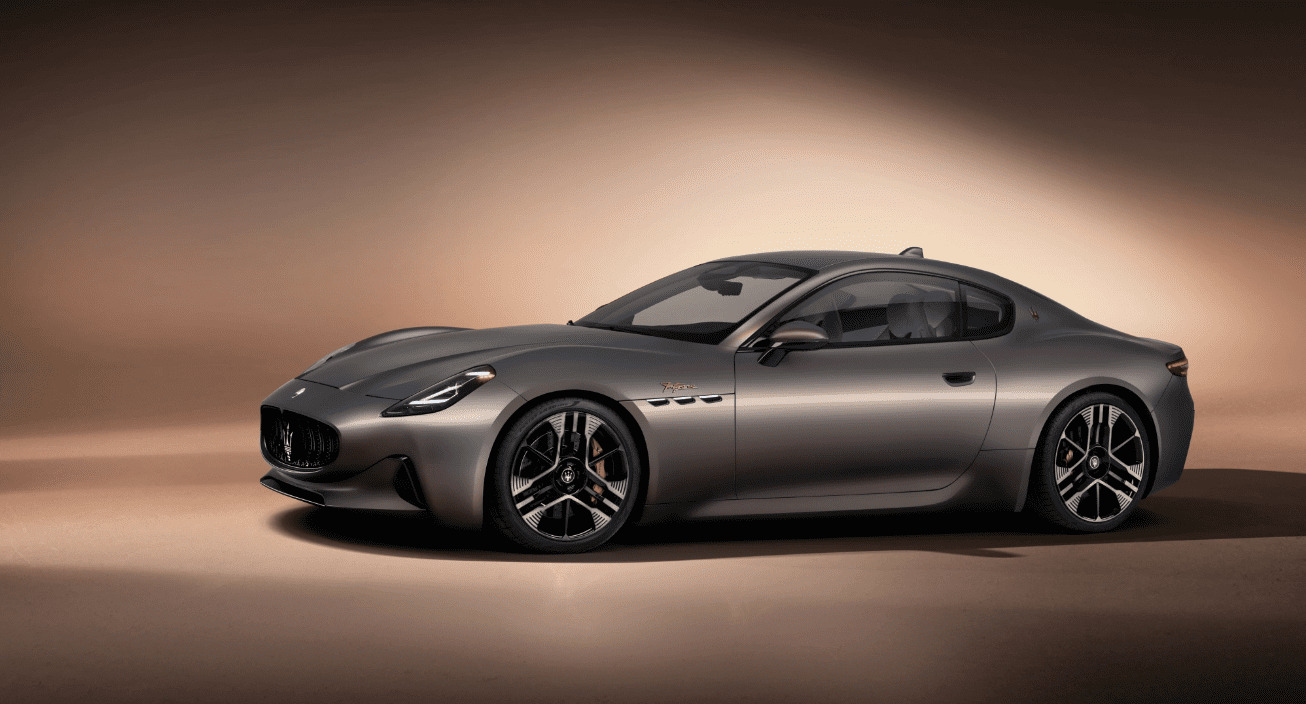
Photo Courtesy Maserati
Maserati GranTurismo: Being under the Stellantis umbrella, Maserati’s EV development is also a little behind other top European brands. However, the electric GranTurismo Folgore model is a good starting point. The Italian luxury carmaker plans to offer fully electric cars by 2025.
The electric GranTurismo will not be short on power and performance. The company plans to use powertrain technology from its Formula E racing team.
The engine will generate 760 horsepower at the wheels, the most powerful Maserati coupe ever built. An 800-volt battery will be attached to the backbone-style chassis in a “T-bone” shape. The body is made from aluminum and magnesium to increase aerodynamic performance.
The electric GT will include an Atlantis High electronic system that improves GPS function. It can send up to 2,000 messages a second to company headquarters about performance issues. Maserati can send over-the-air updates and include a level-5 cybersecurity system in the hardware.
The sound system in the GT is the most impressive, with 19 custom craft speakers installed, thanks to Sonus Faber. Maserati prices the electric GranTurismo at $195,000.
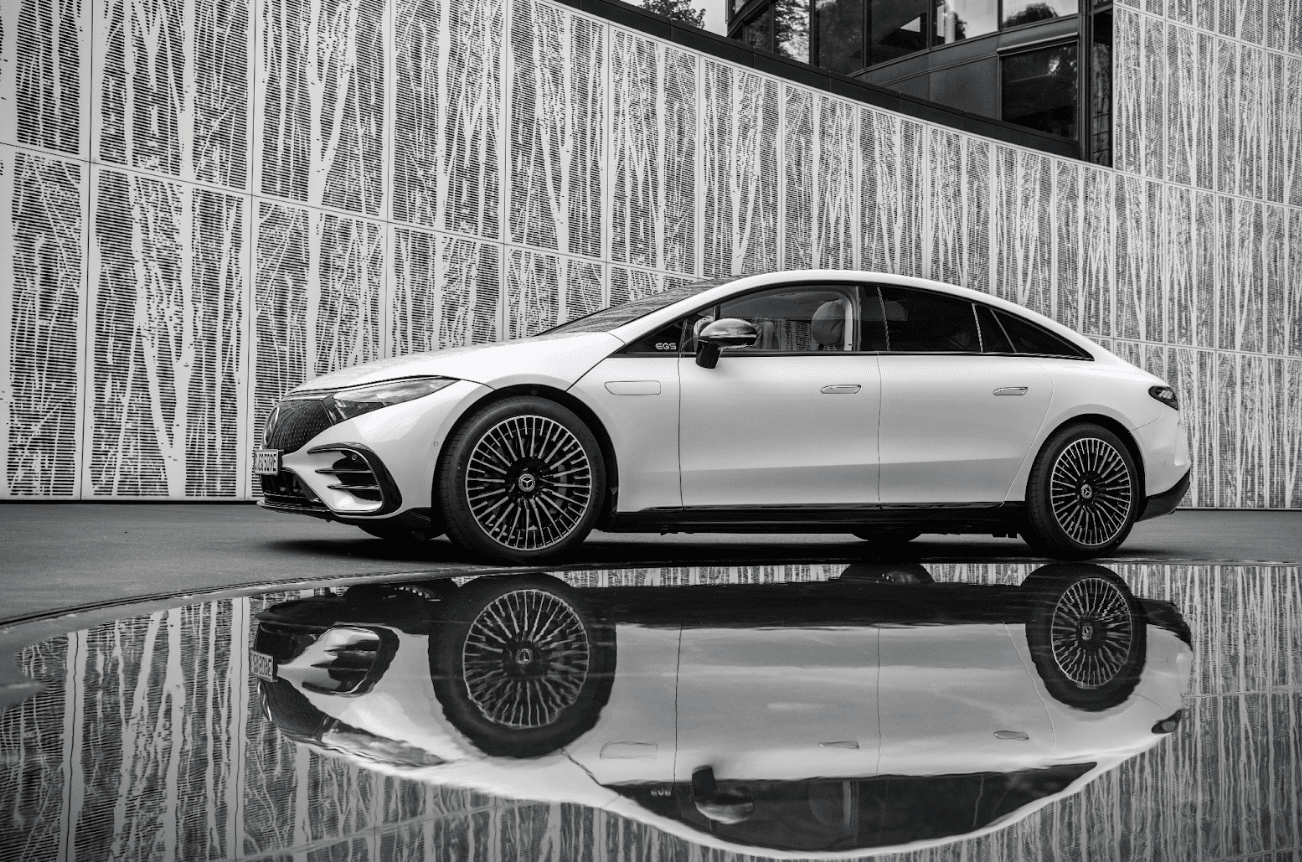
Photo Courtesy Mercedes-Benz
Mercedes EQS: Inspired by the S-Class, the Mercedes EQS is the first EV from the German company. It is one of the most technologically-savvy cars on the market. The door handles are the pop-out kind found on brands like Tesla. Its rounded design has one of the best coefficients with 0.2 flat drag.
The EQS has a dual-motor and all-wheel-drive that produces 516 horsepower. Battery range sits at 340 miles before another charging, and customers can pay for a single-motor, rear-wheel-drive option with 350 miles of range. For a car built for luxury and comfort, it’s pretty fast, boasting 0-to-60 in 4.1 seconds.
Inside the cabin, the Hyperscreen display uses artificial intelligence for a simpler user interface. The safety features include driver assistance systems like self-parking, emergency braking, adaptive cruise control, and active steering assistance. The base EQS costs $106,360, but the AWD version costs closer to $120,000.

Photo Courtesy Mercedes-Benz
Maybach EQS SUV: Mercedes-Benz unveiled the ultra-luxury EV in April 2023 in Shanghai, China. The new Maybach boasts impressive range, performance, and comfort.
Mercedes-Maybach says the EQS can travel up to 373 miles on a single charge, or 600 kilometers, which is a provisional figure. Under the hood, there is a 649 horsepower engine, resulting in an acceleration rate of 0-to-60 in 4.1 seconds.
The top speed was recorded at 130 mph, and AWD comes standard for each model. The battery powers up quickly, recharging up to 200 kW. A direct current can take the battery from 10 to 80% full in 31 minutes.
The interior is an ode to luxury. Features are available like customizing the back seat center console to include two folding tables, a cooling compartment, and silver-plated champagne goblets. Early estimates suggest it will cost around $200,000 for the base model; however, limited editions may cost as much as $300,000.

Photo Courtesy Candela Speed Boat
Polestar & Candela Speed Boat: Polestar and electric boat startup Candela struck a deal to share and supply engine and charging equipment with each other. Candela plans to release a line of vessels for recreational use. These boats have hydrofoils that glide across the water.
This tech doesn’t produce any wake and is quieter than traditional boats. The hydrofoils use 25% less energy since they don’t have to fight the current. When you factor in fossil fuel reduction, these speedboats use 80% less energy. Polestar’s batteries gave Candela the impetus to successfully launch the P-8 and C-8 powerboats.
The company tested the vessels in places like Venice, where boating wakes have eroded parts of the canals. There are plans to use the C-8 as an electric water taxi.
In spring 2022, Candela recorded more than 100 orders for their boats. They’ve outsold some traditional boat brands. Candela also received funding to build a 30-passenger ferry in Stockholm, which is set to be operational sometime in 2023. According to “Inside EVs,”the $450,000 boats are due to be start being delivered in June 2024.

Photo Courtesy Porsche
Porsche Mission E: Following the success of the Taycan and Macan EV models, Porsche is planning a faster, more dynamic electric sportscar. With the body of its flagship 911 muscle car, the Porsche Mission E aims to be one of the best-performing zero-emission sports cars.
The company says the Mission E will have 250 miles of cruising range, with a maximum of 300 miles at full battery. Charging will only take 15 minutes. It’s believed to whip down roads at a max speed of 180 mph.
Porsche’s Mission E puts it ahead of competitors like Ferrari and Lamborghini, who are just beginning their electrification. This new Roadster will give Porsche an edge: a predicted 80% increase in battery-EV sales by 2030. In the short-term, 50% of new car sales will be mixed-battery EVs.
If everything goes to plan, Porsche may decide to build a fully electric 911 car, even though some executives pushed back on that concept.
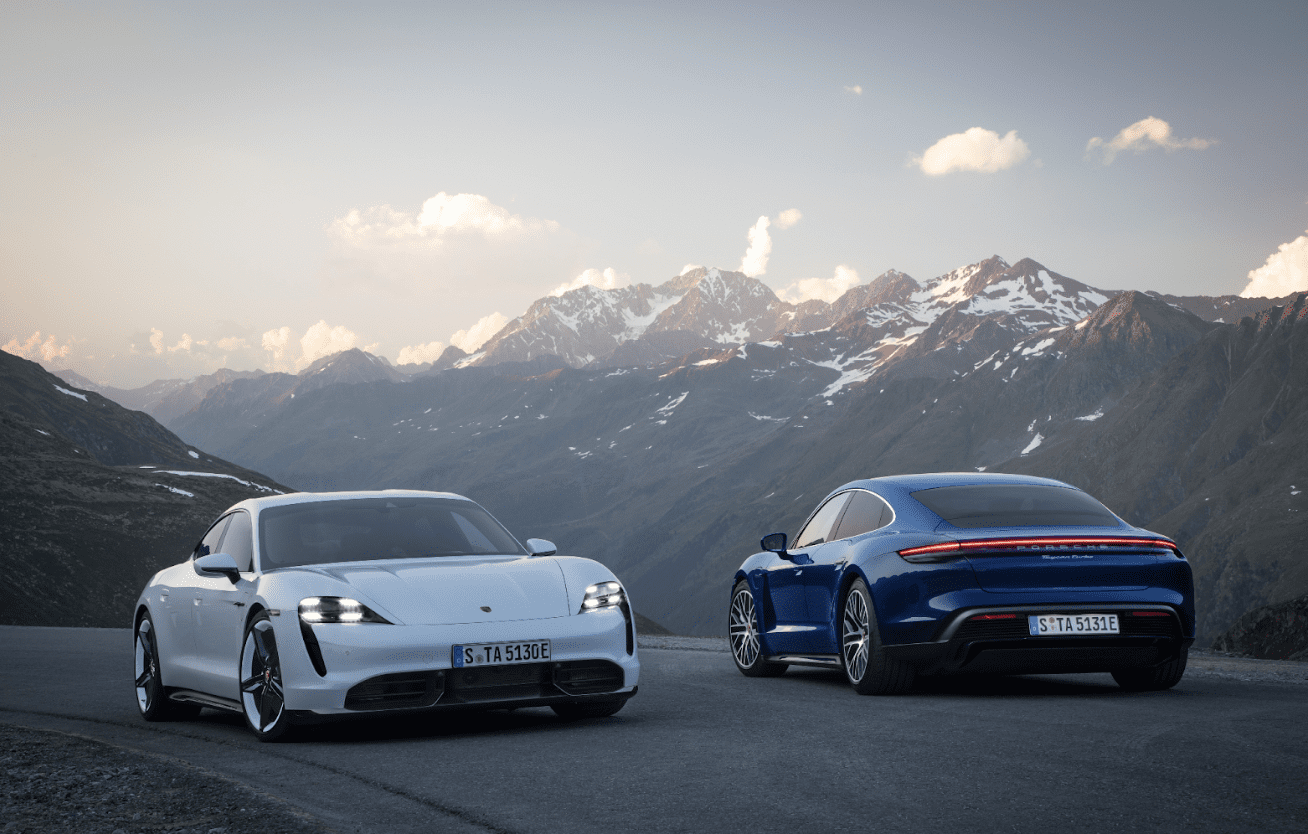
Photo Courtesy Porsche
Porsche Taycan: Porsche designed the Taycan to compete with the likes of Tesla and Lucid for one of the fastest electric cars available. Track tests revealed the Taycan had a 0.22 drag coefficient, on par with Lucid and Tesla’s 0.2. It shares similarities to its Panamera cousin, the most significant difference being the electric motor. The Taycan is shorter and more aerodynamic, though.
The turbo version can go 0-to-60 in 2.6 seconds, and the base model time is around five seconds. It has a two-speed transmission that aids with acceleration time. All Taycan models come with an AWD and dual-engine system.
As for horsepower, there is 402 hp under the hood, which increases in the higher-performances versions. The Turbo has close to 600 hp — it’s fast and handles like a Porsche.
The challenges lie with the range — the Taycan gets 227 miles of range. However, the flip side is the charging rate. With a direct-current fast charger, you can go from 5% to 80% in just 23 minutes.
Inside, the interior mixes minimalism with modernity. The infotainment system is top-notch, with two central touchscreens. The starting price begins at $84,000, which jumps to $105,000 for higher-performance models.

Photo Courtesy Rivian
Rivian R1S: The SUV counterpart to the R1T, the R1S is just as reliable and sleek as its truck predecessor. Rivian claimed both of its vehicles shared 91% of the same components. The big difference is the truck bed on the R1T.
The R1S has a similar performance record, with a 0-to-60 time of 3 seconds thanks to 800 hp in the drivetrain and a quad-motor system to send power to each wheel. There’s also a “torque vectoring” system delivering a precise amount of torque to each wheel. When off-roading, the R1S can handle depths as high as three feet, tow 7,700 pounds, and crawl rock at 100% grade.
In terms of range and charging, the R1S has a 128.9kWh battery giving a respectable 316-mile range. Rivian is developing a network of charging stations, much like Tesla.
Depending on location and battery tech, it will offer 200 or 300kWh chargers.
The interior is designed with vegan leather, a light-colored wood frame, and infotainment displays. The trunk has 104 cubic feet of space plus additional storage under seats and in the front trunk. The R1S will be produced in a new Georgia factory, costing around $72,500 MSRP.
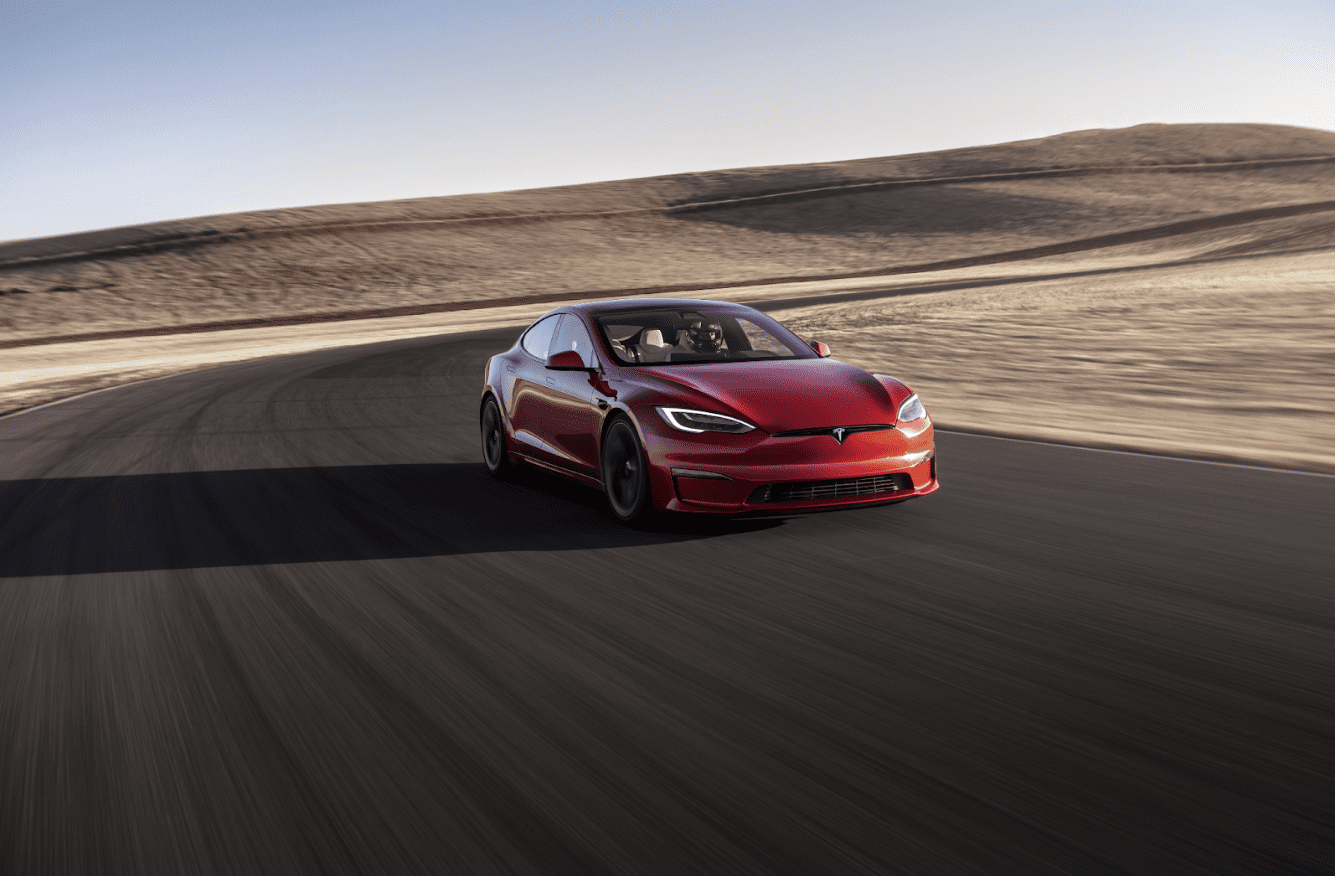
Photo Courtesy Tesla
Tesla Model S: The Model S is setting a new standard for high-performance electric sedans. The car has a similar design to the Model 3 but with a much longer driving range and more power in the engine.
In 2022, Tesla released the Model S Plaid, its most unique car to date. The range is estimated to reach 412 miles before the next charge, one of the best ranges of any EV. When charging, 200 miles can be restored in 15 minutes. In terms of power, the Long Range Model S has a dual-engine motor that supplies 670 hp to the car. It can go 0-to-60 in 3 seconds, and max speeds have hit 155 mph during testing.
The Plaid version’s 0-to-60 time is even more impressive at 2.1 seconds, keeping pace with the Bugatti Chiron Sport, a car that’s 10 times as expensive and even harder to purchase. The Plaid has 1,020 hp and can go up to 200 mph while maintaining the 400 miles of battery range.
The interior has a massive panoramic sunroof, along with all the bells and whistles found in other Teslas. The steering wheel is boxier, almost hexagonal. A large infotainment controls everything inside. For cargo space, there’s a 26-cubic-foot rear space and front trunk.
Safety features include automatic emergency braking and a low rollover rate. The car was designed to withstand the worst accidents. There are some hands-free driving capabilities like lane merge and Full Self-Driving. It’s a pricey car starting at $96,440 for the base model and $130,000 for the Plaid.
Mid-Range
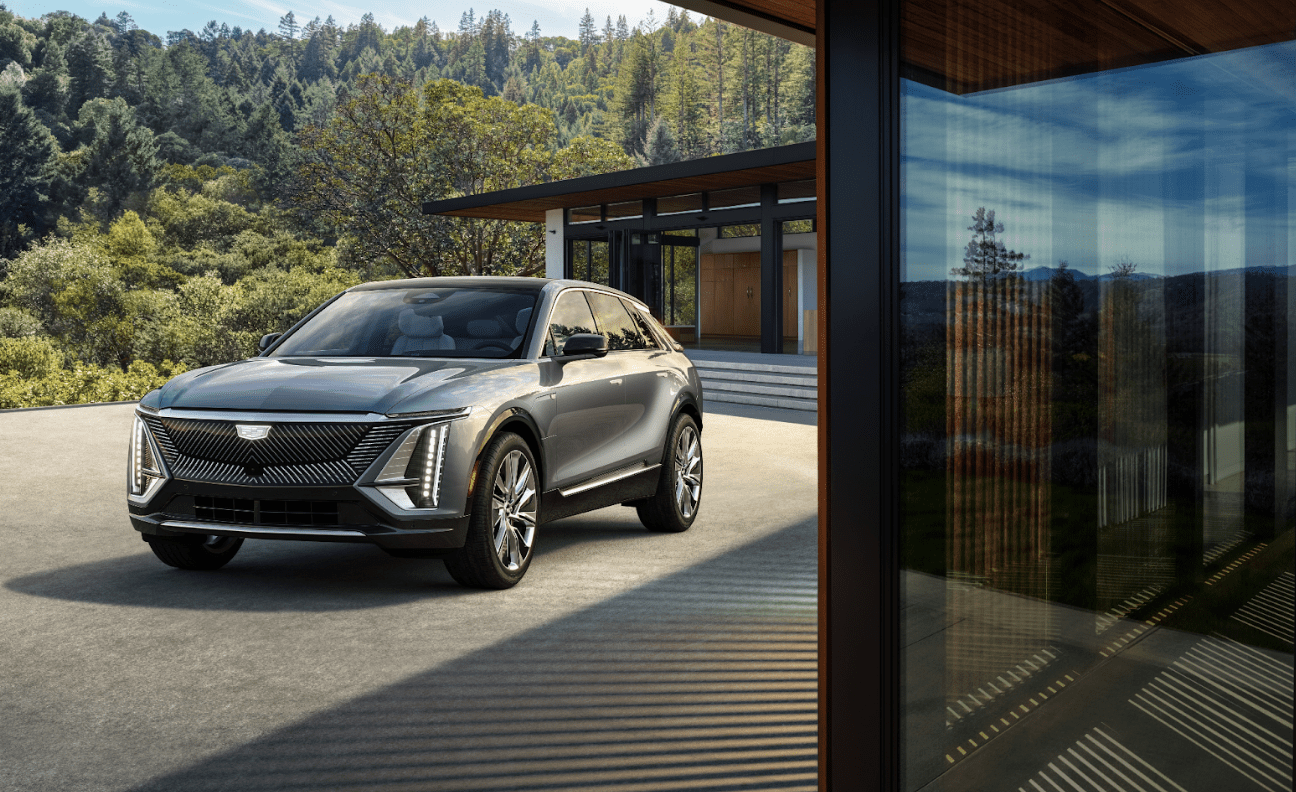
Photo Courtesy Cadillac
Cadillac Lyriq: In 2021, Rory Harvard, Cadillac Global VP, announced the car brand would be going fully electric by 2030, part of GM’s grander electrification plan. It coincided with the announcement of the Cadillac Lyriq, the luxury carmaker’s mid-size EV.
The rear-wheel drive (RWD) SUV comes standard with 340 hp and gets more than 300 miles of range on a single charge. The battery can get 76 miles of range returned with 10 minutes of fast charging. An AWD model is expected to follow soon. The Lyriq has a lot of nifty driver-assist features like automated emergency braking, lane departure warning, and adaptive cruise control.
The interior is extravagant with its digital control center. Rather than a touchscreen, a single knob controls everything.
The interior is also soundproof, so you can comfortably ride and listen to music undisturbed.
The exterior is a modern take on the famous Cadillac bodywork. The charging port is strategically placed, so it looks almost invisible. The lights and grille look like the Cadillac style we know and love, with a light-up logo front and center.
Along with the Celestiq, the Lyriq can usher in a brand-new era for the carmaker. The Lyriq will cost $59,990 and will be available in 2023.
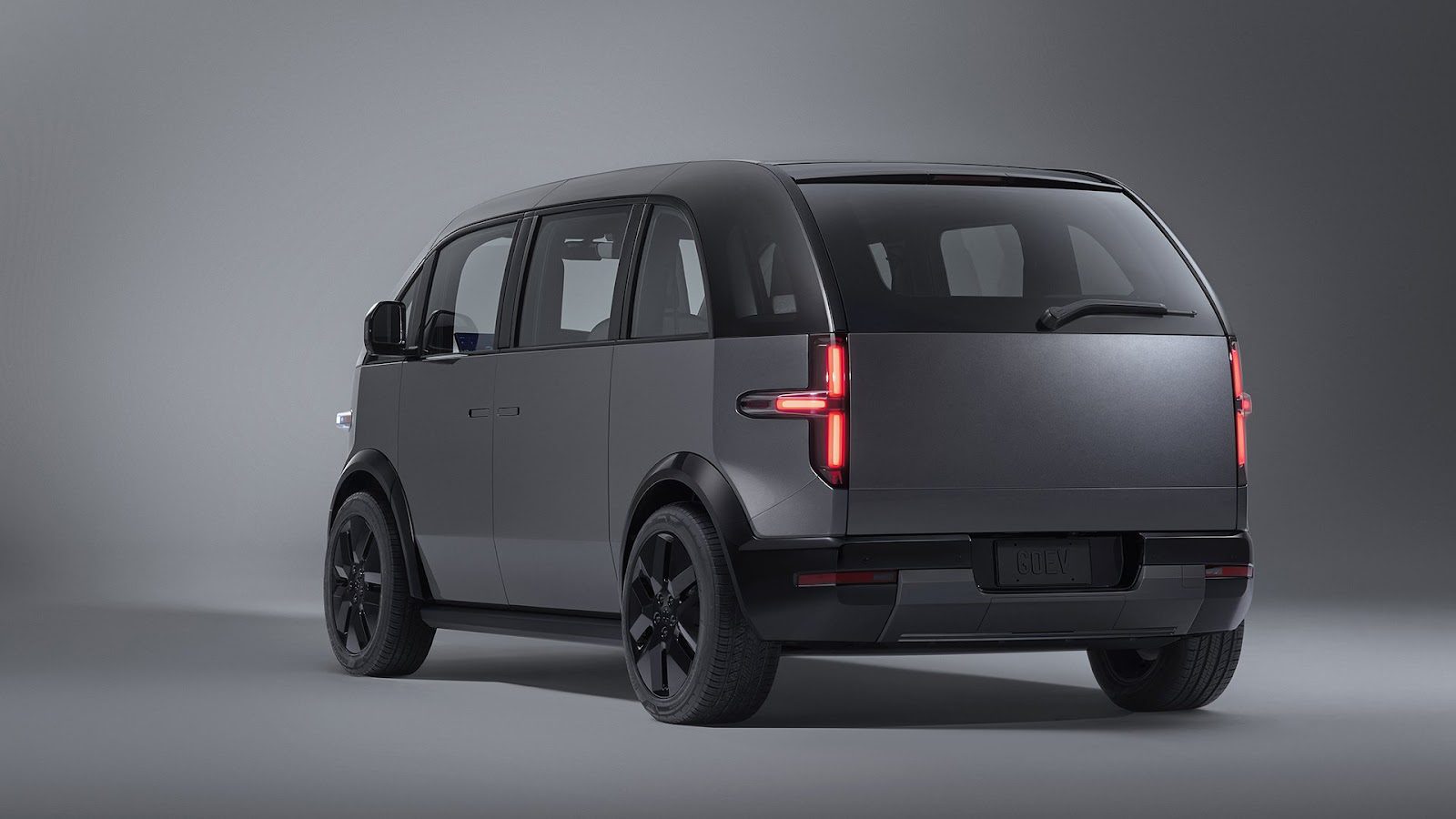
Photo Courtesy Canoo
Canoo LV: Canoo was started by Ulrich Kranz and Stefan Krause, two former employees of Faraday Future. The company’s first vehicle, the Canoo Lifestyle Vehicle, started production in late 2022. The pill-shaped vehicle is different than other SUVs.
The passenger seating is ring-shaped compared to the normal three-across, with 22 windows offering a 360-degree view. The steering wheel is rectangular, departing from the normal circle-shaped wheel. The infotainment system is top-notch, using a Canoo app than a touchscreen. The app controls the music, phone capabilities, and climate control.
The engine performance is decent enough, with 300 hp and a 0-to-60 time of 6.3 seconds. The range sits at 250 miles, respectable enough to get around with ease. The LV charges to 80% in 28 minutes with a fast-charging station. Canoo plans to offer drive-by-wire steering systems, the first brand to use this technology. Twelve airbags are equipped for prime safety measures.
You can order a $34,500 “Delivery” LV without the backseat or opt for the seven-seat Premium option for $50,000. A subscription option also allows buyers to drive the LV month-to-month rather than leasing or buying outright.

Photo Courtesy Chevy
Chevy Silverado EV: As Ford and Rivian roll out their bespoke electric trucks, so are GM and Chevy. The Silverado EV was announced in January 2022, with Chevy dropping hints before the official specifications were revealed.
It’s a two-door truck, boxy in stature, and shares similarities to the Chevy Avalanche truck. The bed is almost 6 feet long with a foldable midgate to create even more space. The front “eTrunk” has 9 cubic feet of storage space.
The Silverado EV is definitely a workman’s truck, with an AWD powertrain with 510 hp. It can go from 0-to-60 in just 4.5 seconds, which is pretty quick for a pickup truck. It can tow close to 10,000 pounds, and a 20,000-pound model is rumored to be coming soon.
A battery like this — 400 miles of range — would need a few hours of charging, but Chevy devised a plan. The dual-layer, 200kWh battery pack is charged simultaneously. The rate allows for 100 miles to be returned in just 10 minutes.
The five-seat interior has a large touchscreen control center and plenty of legroom. There are several safety measures, like blind-spot monitoring and emergency braking.
There’s even semi-autonomous driving with the Super Cruise feature, but this is optional.
Demand was quite high for the Silverado EV, with 140,000 reservations in the first round of orders. The base model will cost around $40,000 and qualify for EV tax credits.
Some amenities that come standard are the hybrid infotainment system, complete with touchscreen and knobs and buttons, and top-tier safety features like driver-assistance technology, lane-keep assist, and automatic emergency braking. The Bolt is joining a growing line of Chevy EVs; the company is planning to go full-electric sales by 2035.
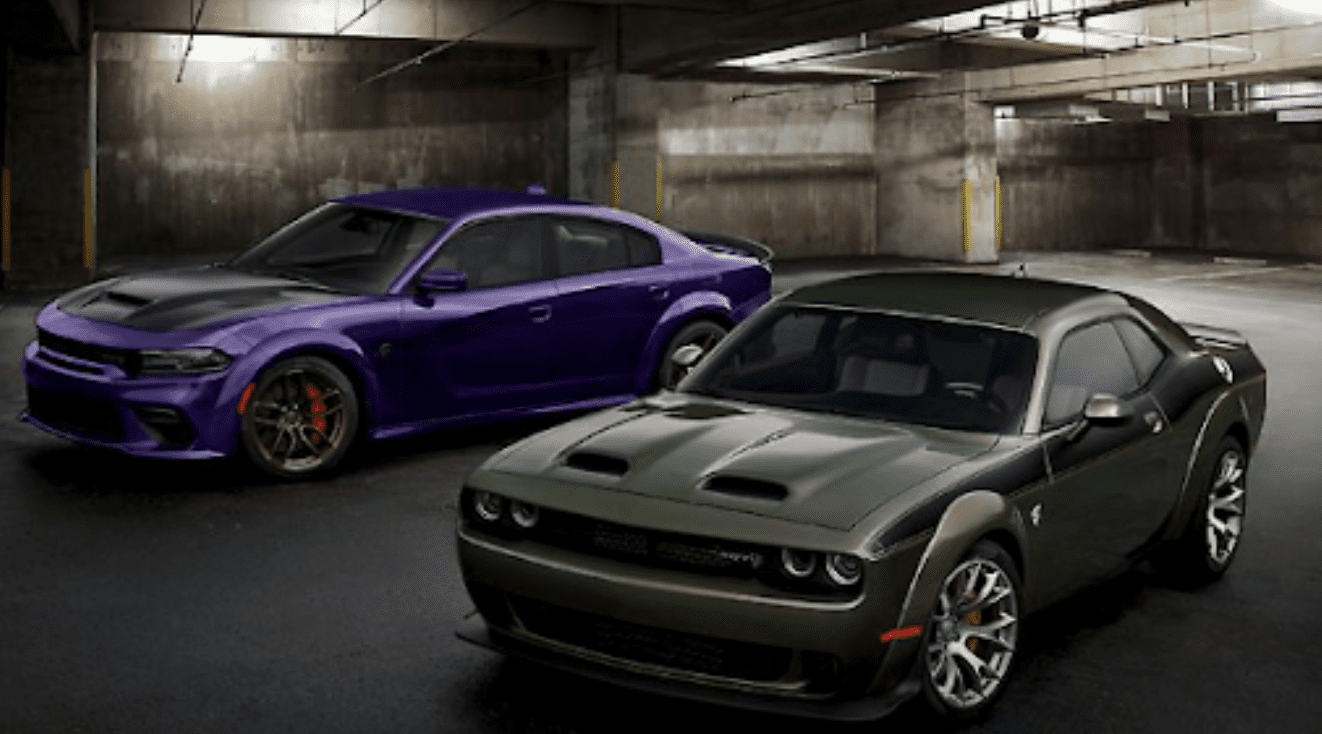
Photo Courtesy Stellantis North America
Dodge Charger/Challenger: Dodge announced the internal combustion Challenger and Charger muscle cars would be discontinued after the 2023 release. Dodge’s parent company Stellantis is overseeing a massive switch to EVs, aiming to get its North American manufacturers at least 50% electrified by 2030.
The American brand joined in and announced that the electric Dodge Charger Daytona model would arrive in 2024. It plans to have all the bells and whistles of the original car, including the roaring engine sound. The decision to end ICE production will see a plant shutter in Brampton, Ontario, Canada, in December 2023.
Dodge CEO Tim Kuniskis has seen the writing on the wall, as his biggest rivals are electrifying at a rapid pace. He felt the company needed to catch up or be left in the dust but also keep Challenger and Charger fans happy.
They’re also catching up to Ram and Jeep in offering EVs, which includes a new SUV called the Hornet. It’s all part of Stellantis’s Dare Forward 2030 electrification strategy. “Car and Driver” estimates the 2024 model to start at $50,000.

Photo Courtesy Ford
Ford F-150 Lightning: The hype around the F-150 Lightning was warranted. The truck has been a smash hit for Ford. In the first round of orders, 150,000 units were reserved. It’s a scaled-down version of the ICE F-150 but still just as utilitarian. The front of the truck uses a light bar and a functional grille, giving it a more modern appeal.
The performance of the Lightning is where it shines. A dual-engine AWD powertrain gives the truck between 426–563 hp, depending on the Standard-Range or Extended-Range battery pack. The acceleration is wicked fast, with 0-to-60 in 4.5 seconds.
The payload capacity sits at 1,000 or 2,000 pounds, depending on the make and model. The towing sits at 7,700 pounds or 10,000 pounds. There are 230 miles of range on the Standard version and 300 miles on the Extended. Fast charging stations can get the battery to 80% in 45 minutes.
The interior is spacious and tech-savvy. The control center is all-digital and has multiple modes like “Intelligent Range” settings. It was a front trunk space for extra storage. It has bidirectional charging that can return power to the grid and serve as a power generator for homes. The F-150 Lightning starts at $51,990 for the base model, but the price goes up for the Extended version.
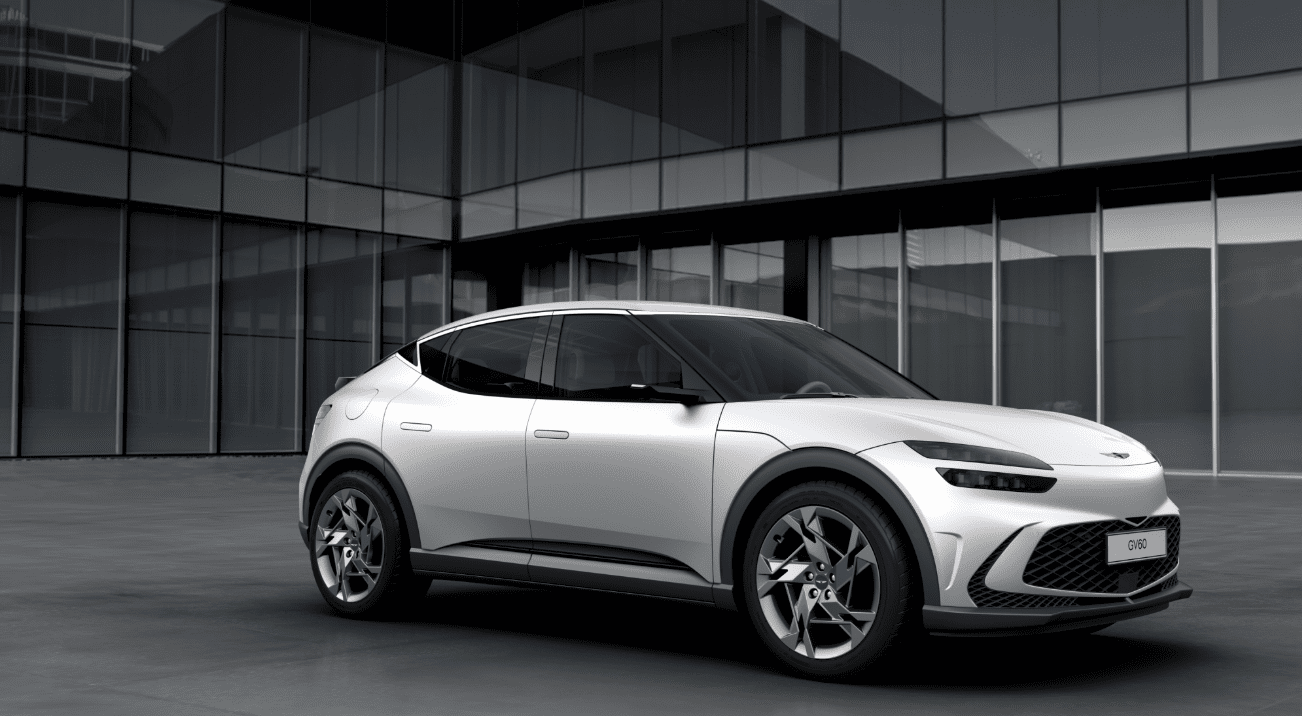
Photo Courtesy Genesis Motors
Genesis GV60: The Hyundai Group has a diverse portfolio of electric cars. Its luxury brand, Genesis, rolled out its GV60 model with resounding success. Car and Driver says the 2024 model will cost $61,745.
The car contains 314 hp in the base model, with 429 hp in the performance version. There’s a Boost Mode feature that can bump the horsepower up to 483. That gives the GV60 an 0-to-60 time at 3.4 seconds.
The range sits at 235 miles, and the long-range base model maxes out at 250 miles. Hyundai’s 800-volt electric platform can charge from 10% to 80% in 18 minutes.
Instead of side-view mirrors, cameras now take up that space. However, it’s unlikely for that feature to make it to the U.S. The driver-side door locks are run with facial recognition for buttonless locking, and a fingerprint scanner turns on the car. It’s one of the most tech-savvy EVs on the market. The GV60 interior is made from faux leather with a digital dash and infotainment system.
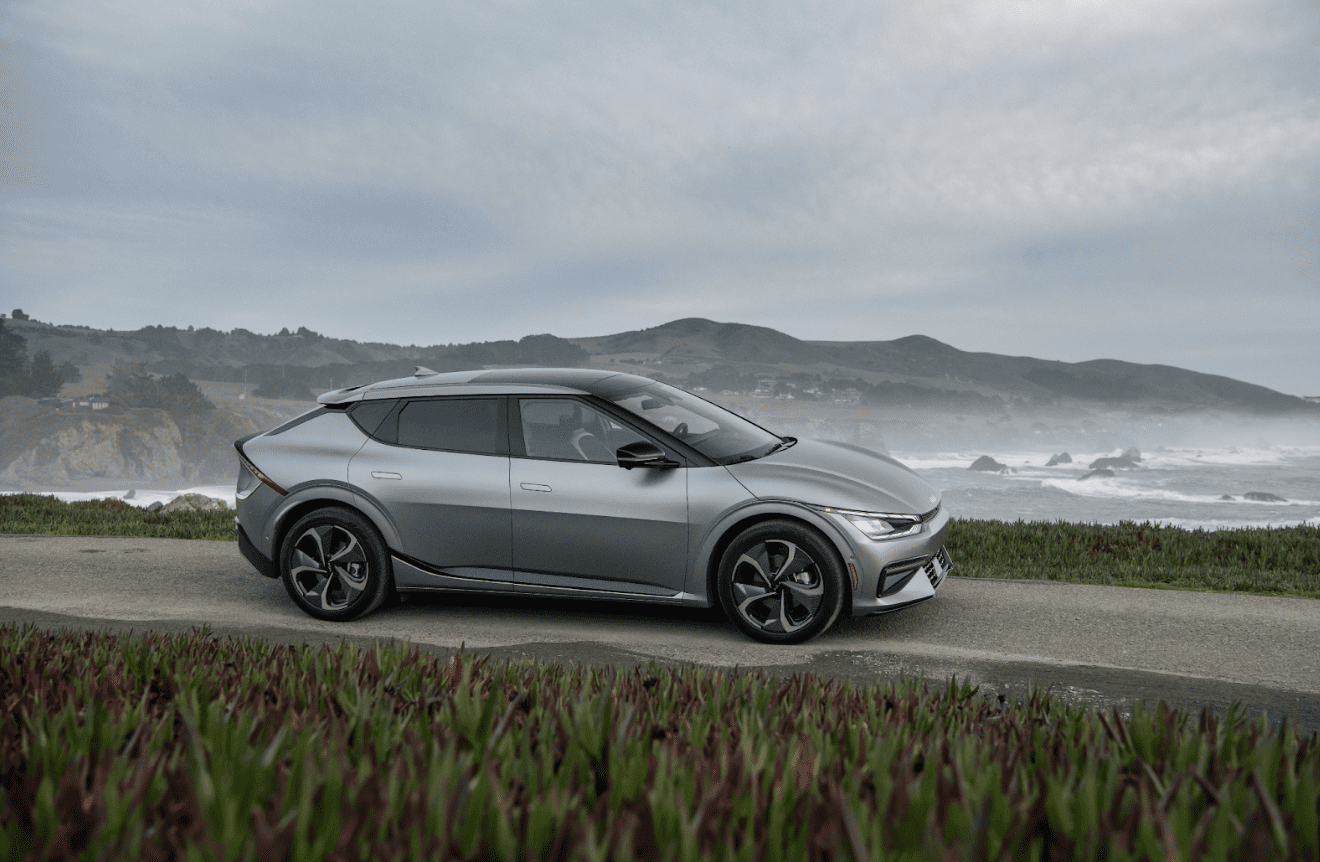
Photo Courtesy Kia
Kia EV6: The Kia EV6 is the brand’s big hit in the American market, using Hyundai Group’s Global Modular Platform, the same used in the Genesis EV lines. The EV6 is a good start to Kia’s electrification path. Rather than include a front-end grille found on ICE models, Kia opted against it for the EV6.
The body design is minimal but sleek, a truly modern car. The EV6’s performance levels are optimal. The RWD model offers 167 hp, while the AWD GT version comes with 567 hp. It’s remarkably fast, going 0-to-60 in 3.5 seconds. Even with such a rapid acceleration rate, the EV6 is ideally a city cruiser than a race car.
The battery range is about 200 miles, not long enough for a big road trip. The RWD version can get 310 miles of range. It has super fast charging capabilities, going from 10% to 80% in under 18 minutes and 70 miles back into the battery in just 5 minutes. DC charging or Level 2 charging should do the trick. A full battery can be reached in seven hours or less.
The interior is quite nice, coming with suede seats and a modern dashboard. The trunk has 24 cubic feet of storage, becoming 54 with the back seats folded down. Safety features include collision avoidance, lane changing, oncoming traffic alerts, and pedestrian braking. The base EV6 costs $42,000, and the GT model costs $52,000.

Photo Courtesy MOKE International
MOKE Californian: MOKE was once a premier beach cruiser found across the Pacific Coast and the Caribbean and driven by major celebrities like The Beatles and The Beach Boys. This British Jeep-esque vehicle was a cult classic. After 40 years, MOKE is returning to North America.
The new electric MOKE can reach 50 mph and has 80 miles of range in the battery. The company estimates claim full battery can be reached in four hours. Through a partnership with EVT Technology Group, MOKE hopes to capitalize on the nostalgia of the 1960s to reestablish its international presence, only this time with electric modifications.
The Californian was in high demand in Europe, and customers remained interested in America. This model is the first revamped 60s car transitioning to 100% electric power. Despite ending production of the internal combustion engine (ICE) models in 1993, Californians remained popular in beach-front towns. MOKE fans can order the electric Californian online with a refundable $990 pre-order fee before paying $41,900 MSRP.

Photo Courtesy Nissan
Nissan Ariya: Following the success of the LEAF is the Nissan Ariya. The automaker’s first electric SUV is a futuristic electric car. Through a partnership between Renault, Mitsubishi, and Nissan, an electric platform called the Common Modular Family-EV (CMF-EV) platform. This system made the production of the Ariya much easier.
The car itself was made with “Timeless Japanese Futurism.” It combines modern power with the minimalism Japanese cars use in design. What you get are reliability and solid performance.
The interior is designed to give you what you need, nothing flashy or fancy. The center console contains the shifter and storage compartments. The engine gets 300 miles of range before the next charge, on par with the Tesla Model Y.
The e-Pedal regenerative braking system sends the charge back to the battery. The 0-to-60 test clocked the Ariya at 4.9 seconds. Horsepower is 238 in the AWD version; 214 in the FWD version. The ProPILOT Assist 2.0 system makes the Ariya incredibly safe with many hands-free driving safety features. The base Ariya starts at $47,125.

Photo Courtesy Polestar
Polestar 2: The luxury side of Volvo’s burgeoning EV fleet, the Polestar 2 is the first fully electric sedan. The Polestar 1 was a plug-in hybrid electric vehicle (PHEV) that sold out in spectacular fashion. While the 1 was a larger sedan, the 2 takes a different approach.
Its exterior looks like a Volvo sedan, but its small stature and pleasant appearance make it attractive for the modern car buyer. It’s not over the top.
Performance-wise, a single-engine front-wheel-drive option provides 270 miles of range. There is a dual-engine model with 249 miles as well. The acceleration is quite nice, with 0-to-60 in 4.5 seconds. There’s about 408 horsepower in the engine. Charging to 80% only takes 40 minutes with fast chargers.
The 2’s interior follows the minimalist approach, too. Vegan leather lines the seats and steering wheel, and recycled wood makes up the dash. The touchscreen is small compared to other EVs but still comes with Andriod Auto in the infotainment. The flashiest aspect of this car is the orange seatbelts.
The safety features are still top-notch, as one would expect with Volvo. For a luxury EV, it costs a modest price of $47,200 for the single motor and $51,200 for the dual motor.


Photos Courtesy Lightyear/Sono Motors
Sono Motors/Lightyear: We’re including Dutch EV producer Lightyear in this section. Much like Sono, Lightyear is building EVs with solar panels integrated into the car’s frame. Both automakers are making concerted efforts to make solar-powered EVs a reality.
Lightyear was founded in 2016 and launched the Lightyear One shortly after. The company has set a goal of delivering a car that will need to be cord-charged only once or twice a year. It can travel 440 miles on a single charge, a better range than most Teslas. Lightyear’s car charges 7.5 miles an hour, meaning you can leave it parked, and the sun will power it.
The price starts at $175,000. More Lightyear vehicles are coming in 2024 or 2025.
Sono has been developing solar voltaic vehicles for some time. The company was created in 2015 and developed the Sono Sion, its first EV.
The Sion is basically a solar-powered hatchback; 248 panels charge the vehicle. The range sits at 190 miles before needing a charge. The car can gain 70 miles per week through the solar charging system.
It’s relatively affordable, too, starting a $32,000. The Sion is releasing in 2023, but only in Europe at this time.
Photo Courtesy TELO Trucks
TELO Trucks: TELO Trucks is designing a new small-size pickup that can fit five passengers and has a cab and flatbed the size of a Toyota Tacoma. It’s only the length of a two-door Mini Cooper SE — 152 inches long.
According to the company, it will accelerate from 0–60 mph in 4 seconds, with a battery range of around 350 miles and 500 horsepower in the drivetrain. The startup estimates the battery will power up from 20% to 80% in just 20 minutes with fast charging. It comes equipped with advanced safety technology to prevent collisions and other incidents. It’s expected to be a light, easy-maneuvering truck, reaching a top speed of 125 mph.
TELO’s truck offers more than just a large flatbed. A storage tunnel under the bed will be available to store all your dirty items, leaving the top clean. Even with five-person passenger seating, you can still have long objects in the back.
The trucks are expected to be ready in 2025, followed by mass delivery in 2026 through scaled manufacturing. It will have a base price of $49,000 without federal tax credits included. You can pre-order for $152, a dollar per inch of the car.
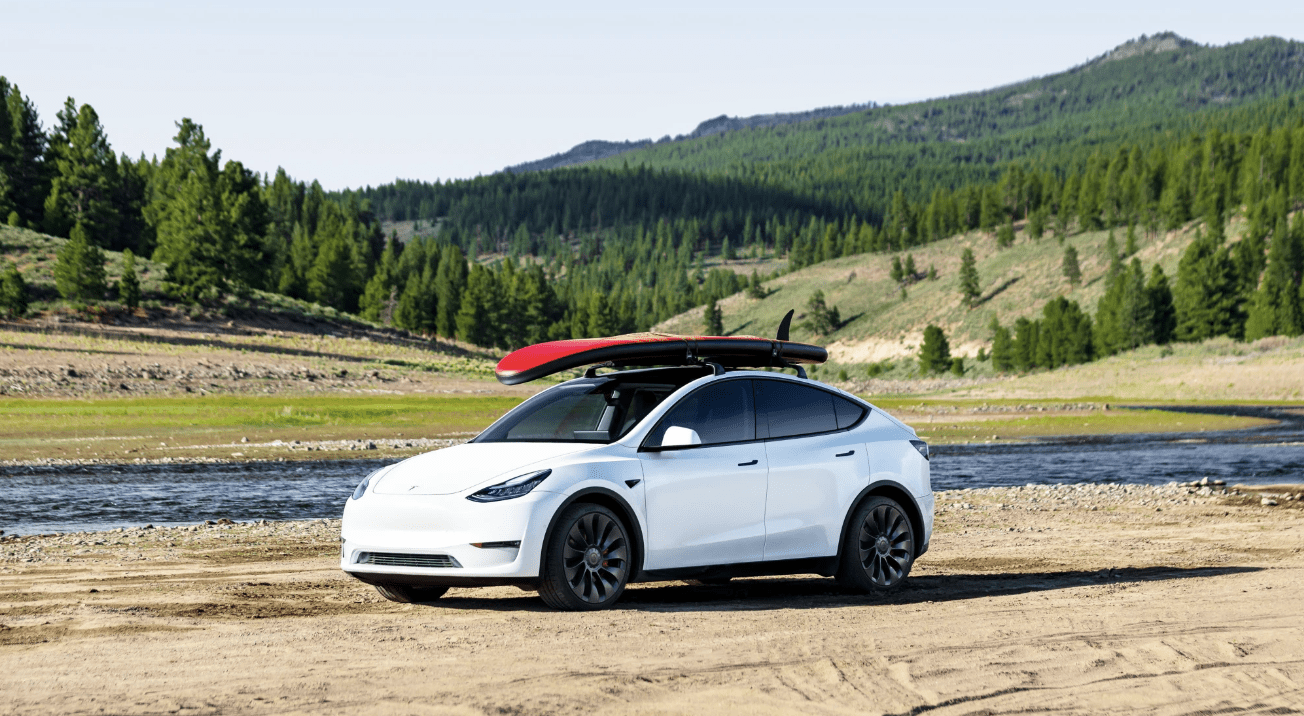
Photo Courtesy Tesla
Tesla Model Y: Building off the success of the Model 3, the Model Y is essentially the continuation of Tesla’s dominance. The car is a larger version of the Model 3, with the same style and aesthetics, just a touch bigger.
The performance of the Model Y is complete with 330 miles of range. Tesla’s network of Superchargers can return 200 miles to the battery in 15 minutes. It’s pretty quick, with a reported 4-second 0-to-60 time. It has several safety features like lane-keeping, automatic emergency braking, surround-view camera, and blind-spot warning. There are semi-autonomous driving features like a Full Self-Driving system.
The cabin is spacious and luxurious. A 15-inch touchscreen infotainment system controls the car’s media, and climate control unlocks the doors and opens and closes the glove compartment.
The seats are made with vegan leather, and passengers sit under the all-glass tinted roof.
The infotainment system has a ton of media apps installed, like Netflix, Hulu, and YouTube, to pass the time during charging. The cargo compartment has 68 cubic feet of storage space. The Model Y Long Range model starts at $64,440, and the Performance Version costs $69,440.
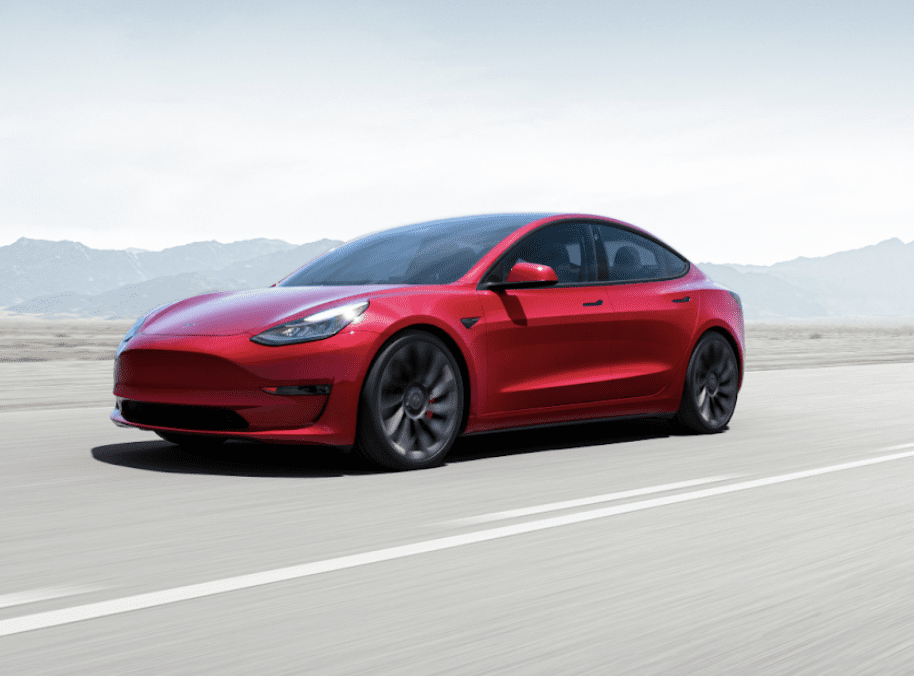
Photo Courtesy Tesla
Tesla Model 3: Released in 2017, the Model 3 has propelled itself to the top of the EV sales chart, becoming the best-selling EV of all time. With more than 1 million units sold, Tesla has hailed its flagship EV for changing the narrative on electric power.
The Model 3 comes in RWD or AWD, mid-level Long Range, or high-end performance models. The battery offers 358 miles for the Long Range variant, but the RWD model has 272 miles. Both are impressive ranges, and both batteries can be charged to 80% in under 40 minutes.
It’s pretty fast, too, going from 0-to-60 in 3.5 seconds, beating competitors like BMW and Porsche. Even the Long Range and RWD have commendable 0-to-60 times at 4.1 seconds and 6 seconds, respectively.
The interior is about as modern as you can get. The central infotainment center controls just about everything inside, like Bluetooth, media, and climate control. There’s a massive trunk in the front, thanks to the skateboard-style drivetrain Tesla builds its vehicles with.
The drivetrain also makes the Model 3 safer and less likely to roll over in accidents. There’s also emergency automatic braking, collision warnings, blind spot monitoring, and adaptive cruise control. Self-driving features like Autopark, Summon, and Smart Summon are included on top of the Full Self-Driving.
The Model 3 isn’t too expensive either, starting at $46,990 for the RWD version. The lower price has sprung Tesla to the top of the charts.

Photo Courtesy VW
Volkswagen ID.4: The ID.4 is Volkswagen’s (VW) flagship electric car. The crossover initially debuted as the ID. CROZZ, a futuristic EV that looks like it came straight from a video game. The ID.4 is more like the modern crossover, with an aerodynamic shape and rounded chassis. It can seat five people.
The interior’s leather is made out of cloth rather than animal skin. The infotainment system is minimalist compared to some other brands, but it functions well. There are five different driving settings to choose from. There are AWD and RWD options. The AWD model hits 60 mph in 5.4 seconds, while the RWD version hits 60 mph in 7.5 seconds.
Battery range sits at 280 miles, and 80% charge only takes 40 minutes with DC fast charging. It also has a regenerative braking system to restore charge to the battery cell during the slowdown.
Safety is a top priority for VW, with emergency braking, lane departure warning, blind spot recognition, and others included in the ID.4. It’s pretty affordable, too, starting at $33,000 and qualifies for the clean vehicle tax break.

Photo Courtesy VW
Volkswagen ID. Buzz Van: The iconic VW Microbus is getting an electric makeover. In late 2022, VW announced the brand’s flagship 60s vehicle would return to showrooms in 2024. The ID. Buzz falls under VW’s electric fleet, using the power of nostalgia mixed with modernity to attract customers. “Car and Driver” estimates that the 2025 model will start at $40,000.
It’s a heavy vehicle, weighing 5,400 pounds and 185.5 inches long. It’s about the size of a compact crossover in the States. Early testing of European models showed a lot of promise, offering an alternative to the classic minivan. The ID. Buzz is expected to use the same battery packs found in the ID.4 SUV, with 300 miles of range.
The interior is made with sustainable materials, and the center console can be removed to fit more people or cargo. Early charging tests show that the European model offers direct-current charging from 5% to 80% power in just 30 minutes. It also has bidirectional charging to help power homes and return power to electrical grids.

Photo Courtesy Volvo
Volvo S60 Recharge: The S60 sedan is the best mix of reliability and speed. This hybrid car gets 415 horsepower and a 2.0-liter four-cylinder engine. It’s not the fastest car compared to BMW or Mercedes, but it’s no slouch either.
It’s more affordable compared to some of the luxury brands. The listings start at $48,000, and you can save even more money with fewer trips to the gas pump. If you only use electric power, the plug-in hybrid gets up to 74 eMPG and 41 miles. The S60 only hits 78 mph max speed with electric, but more when you utilize the hybrid power. It can still go 0-to-60 in 4.1 seconds — pretty fast for a car designed for comfort.
The interior is entirely leather-free. Even the key fobs eliminate leather from the design. Seats have massage technology, and ambient lighting illuminates the cabin nicely.
This EV will be the first Volvo car manufactured in the U.S. A new South Carolina factory is pumping out these cars as the Swedish carmaker wants to make at least 50% of all vehicles with electric or hybrid engines by the end of 2025.
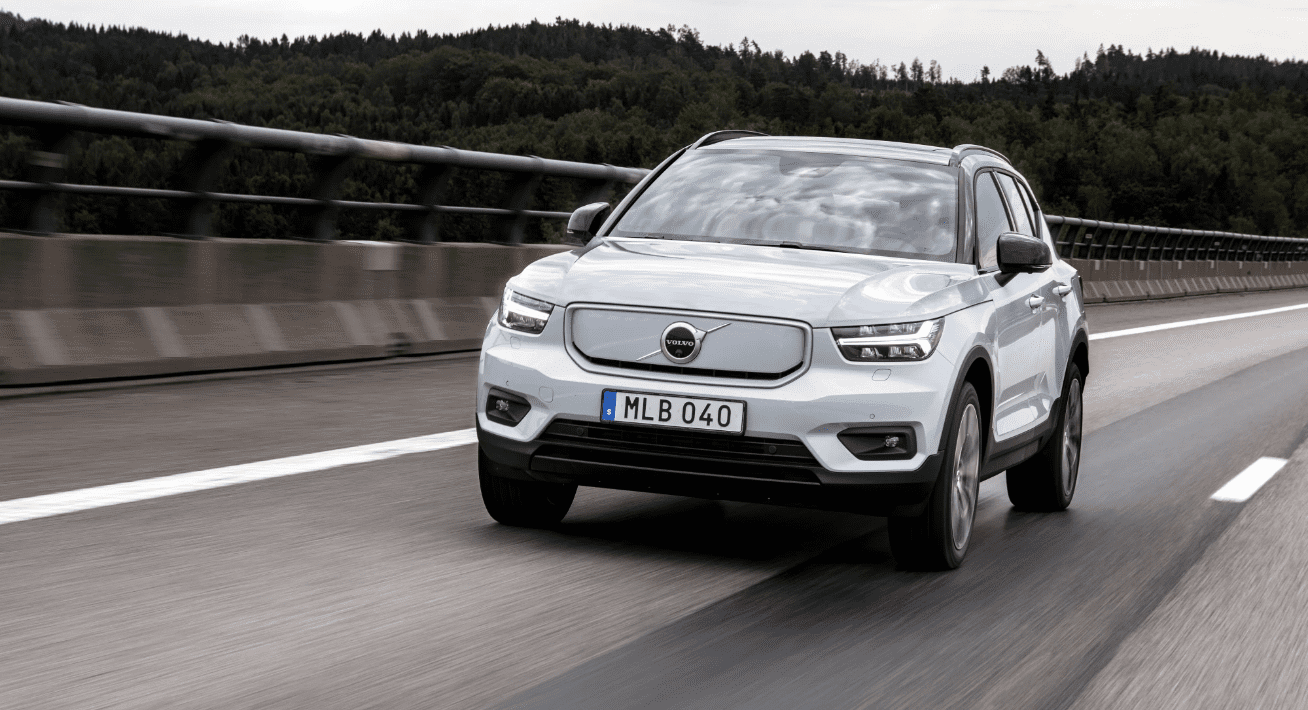
Photo Courtesy Volvo
Volvo XC40 Recharge: The XC40 is Volvo’s first pure electric SUV. The company partnered with Swedish battery company Northvolt to improve battery range up to 600 miles, but not much changed with the exterior design. It’s essentially a copy of the ICE XC40 but with Volvo’s Recharge technology under the hood instead.
The powertrain gives off 402 horsepower for a 0-to-60 time of 4 seconds, making it a very fast electric SUV. However, the battery range is 223 miles. The good news is a regenerative braking system sends charge back to the battery. With DC charging, one can reach 80% charged in 37 minutes.
Volvo is known for its incredibly safe cars, and the XC40 is no different. It has tons of safety features like pedestrian detection, steering assist, and blind-spot monitoring. The interior is the same as the ICE model. There isn’t a ton of legroom, but the trunk is big enough for large cargo. The base price is $52,795.
Economy
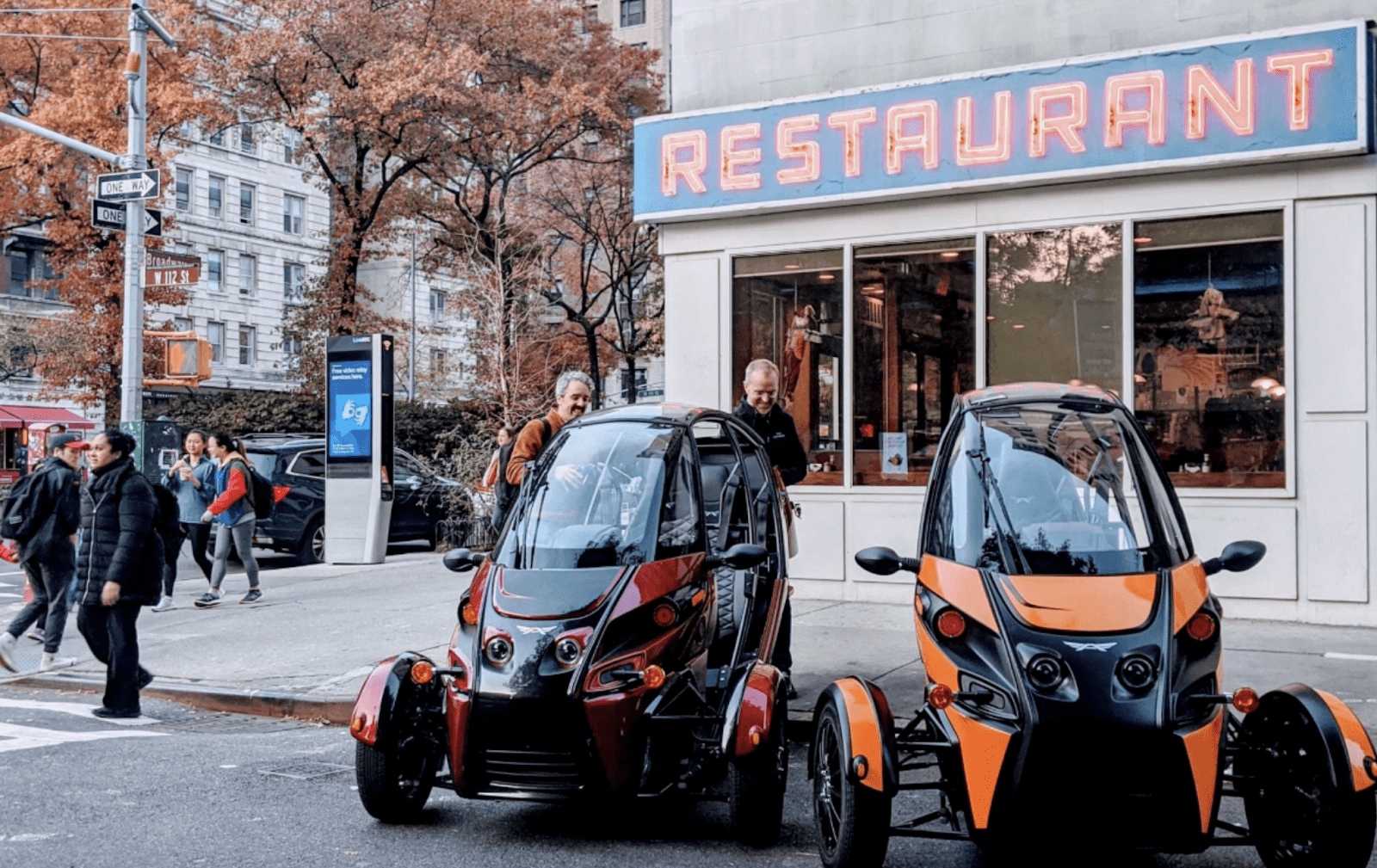
Photo Courtesy Arcimoto
Acrimoto: Acrimoto is a Portland, OR-based vehicle manufacturer creating what they call a “Fun Utility Vehicle,” or FUV. The three-wheeler is a combination of a motorcycle and a golf cart. The company believes the FUV is a sustainable way of reducing emissions in urban areas.
The compact vehicle can weave traffic with ease. It gets up to 102 city miles before it needs charging. The battery gets around 173.3 mpge — pretty outstanding mileage. It’s relatively affordable, starting at $17,900.
The FUV isn’t just for fun; it can be used for various industries. First responders, food delivery services, and filmmaking crews have already taken advantage of the vehicle’s pace (75 mph) and traffic dodging. Wahlburgers in Key West, FL, and JOCO Foods in New York City are using Acrimoto’s Deliverator model for pilot delivery programs.
Arcimoto sells these three-wheelers in California, Washington, Oregon, Arizona, and Florida. Cities like Portland, San Francisco, and San Diego, and Orange County, CA, will have dealerships. The biggest obstacle is getting people licenses to drive the FUVs, which are classified as motorcycles in most states. However, Hawaii passed a law classifying these types of EVs as “autocycles,” which only need a standard driver’s license. More legislation changes in other states could help spur growth.

Photo Courtesy Chevy
Chevy Bolt: The Chevy Bolt is your basic hatchback but with no gasoline required. It’s a sporty vehicle with a nice geometric shape, intelligent design, and aerodynamic structure. The Chevy designers made this car look comfortable with a minimalist appeal.
It’s an economical EV; the range sits at 259 miles, better than the Hyundai Kona Electric but just short of the Telsa Model 3. However, it’s cheaper than both, with a $31,500 MSRP.
The car is FWD and has 200 hp in the engine, going 0-to-60 in 6.5 seconds. A dual-charging cord can plug into a Level or Level 2 charger, so you don’t need a home charger with the Bolt. The car can regain 100 miles in just 30 minutes with a Level 3 charger.
The Bolt also has regenerative braking to ease range anxieties. The compact hatchback only has 17 cubic storage space, but lowering the seats gets more.

Photo Courtesy BMW Designworks
Cru, By Club Car: Club Car worked with BMW’s Designworks and unveiled prototypes of the Cru, a multi-seat cart-style EV. It’s street-legal, with a top speed of 25 miles per hour, and can be driven any roadway with a 35-mile-per-hour speed limit.
Club Car calls this cart the Neighborhood Electric Vehicle (NEV), ideal for getting around a culdesac or hitting the market. It can seat up to six people, and there’s a deployable table put under the rear seats. That’s great for enjoying snacks or a quick board game.
The Cru can be fully charged in six to 14 hours using a 110-volt or 120-volt outlet and the supplied charger — depending on battery discharge. And don’t expect to go incredibly far. The range is about 15 to 20 miles before the next charge. It has a starting price of $27,000.
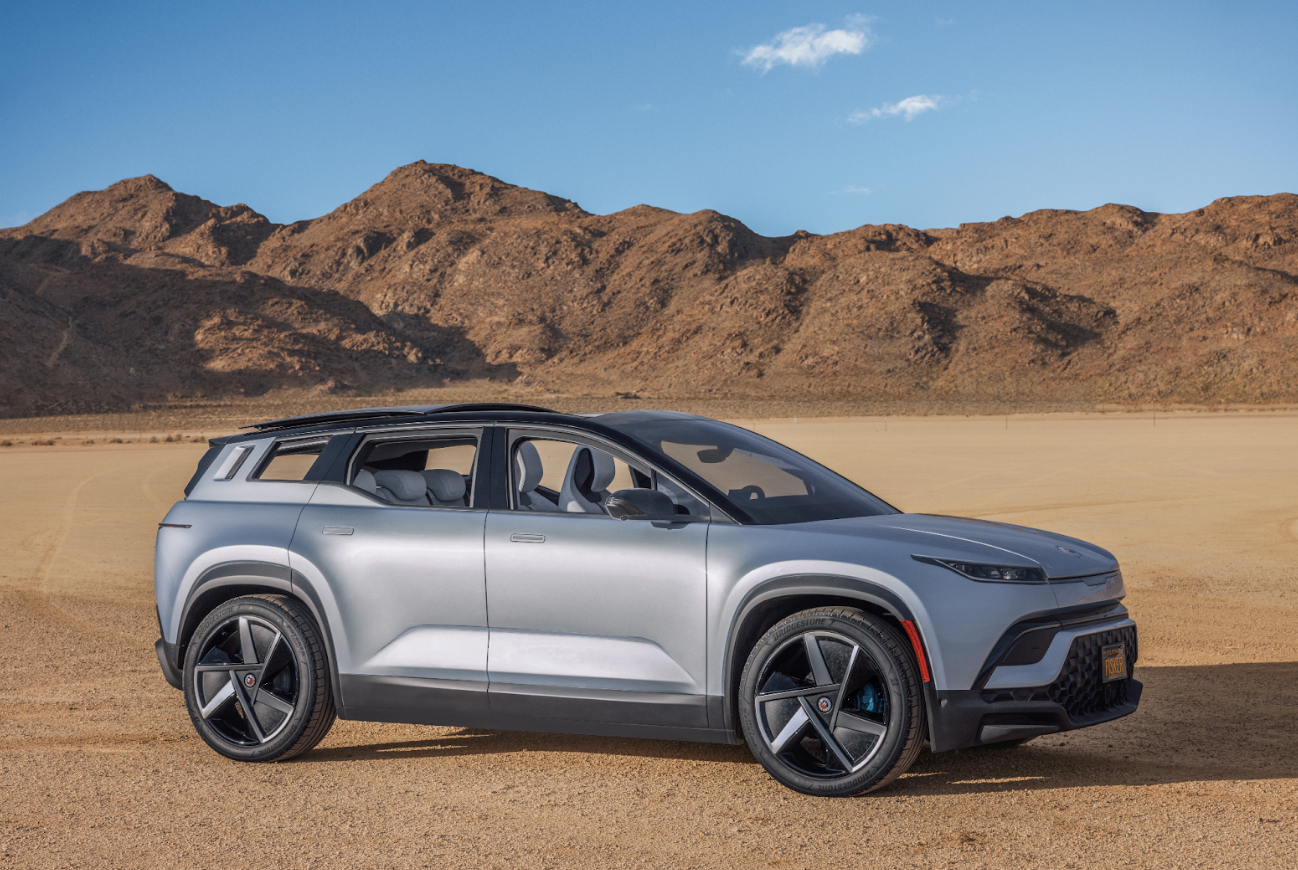
Photo Courtesy Fisker Inc.
Fisker Ocean: Fisker Automotive, Inc. was founded by legendary auto designer Henrik Fisker. Having worked at distinguished auto groups like BMW, Aston Martin, and Ford, Fisker ventured on his own to design a new plug-in hybrid car, the Fisker Karma. Despite a dicey legacy, Fisker endured and created the Fisker Ocean, his first all-electric car.
The Ocean is a futuristic SUV with 22-inch wheels and a sloping shape. It looks like the Range Rover Evoque. Solar panels have been integrated into the car’s roof to charge it while parked. The windows all lower when the EV enters “California Mode,” letting in natural light and air.
The interior is unique. The dash and seating are all made from sustainable or recycled materials, including recycled t-shirts and fishnets. The seats are one integrated unit instead of separate chairs.
The engineering is just as impressive. The Ocean’s battery can go 350 miles before the next charge. It can go 0-to-60 in 3.6 seconds and comes with 550 hp. It can recharge 200 miles in 30 minutes with one of Electrify America’s charging ports. Fisker said customers will get complimentary charging for a year.
The safety features include emergency braking, traffic light/sign recognition, and collision avoidance. The Ocean starts at $37,499 for the Sport model but qualifies for the clean vehicle tax credit.
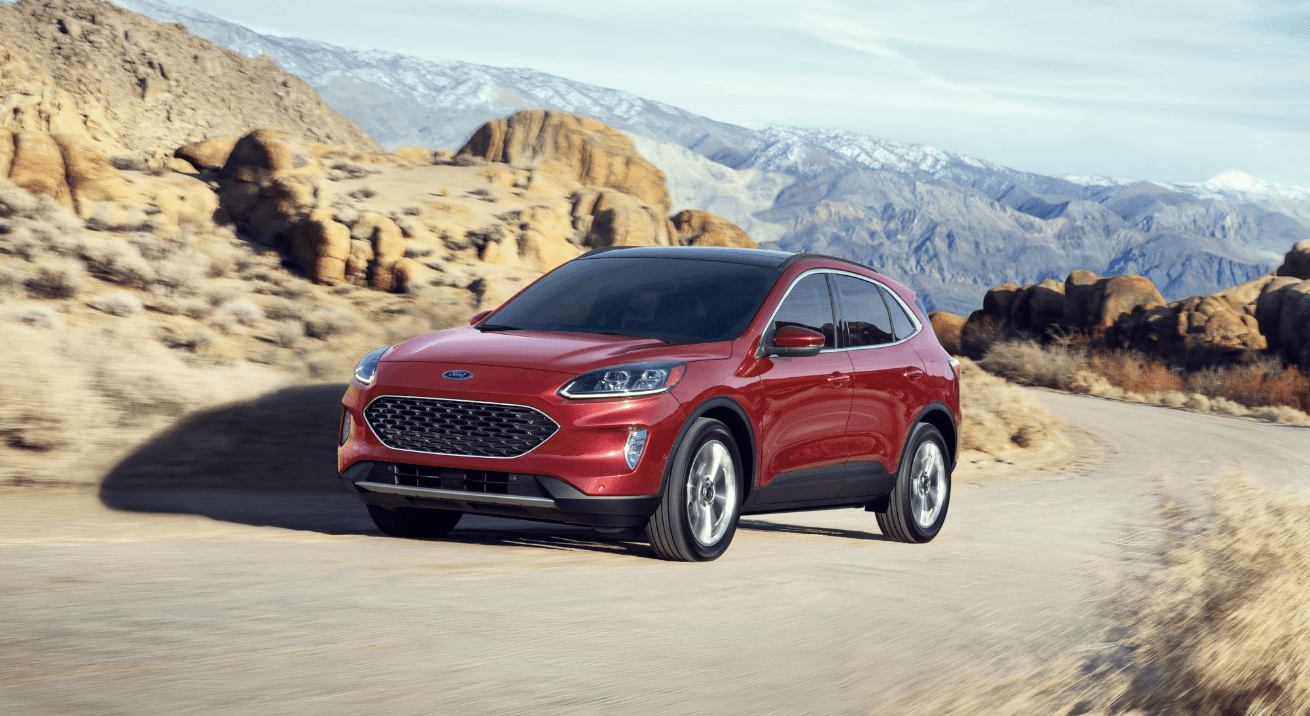
Photo Courtesy Ford
Ford Escape PHEV: Following the success of the Mustang Mach-E and F-150 Lightning, Ford rolled out the Escape PHEV. A zero-emission version of their patented small-size SUV, the Escape PHEV delivers the reliability of Ford with a green thumb.
The 221 hp power engine has more horsepower than the base model and regular hybrid version. The acceleration time is decent, with 0-to-60 in 7.7 seconds. That’s also thanks to a 2.5-liter four-cylinder engine. The electric motor gives the car 37 miles of range, plenty for the daily commute. The car gets 40 mpg on gasoline power, on par with the normal hybrid.
The Escape PHEV has several drive modes that allow flexibility between the ICE and the electric engine. The system can help save the battery or use only electric power.
The SUV has a regenerative braking system sending charge back to the battery, and a “brake coach” will tell you how much was returned. The battery can be fully charged in 3.5 hours using a Level 2 charger.
The interior is practical, with faux leather seats, a digital dashboard, an infotainment center, 34.4 cubic feet of trunk space, and plenty of cup holders. Safety-wise, there’s pre-collision assist, SOS post-crash alert systems, emergency braking, blind spot sensor, and lane-keeping technology. The Escape PHEV starts at $35,455 and is eligible for the clean vehicle tax break.

Photo Courtesy Ford
Ford Mustang Mach-E: The Mustang Mach-E debuted in 2020 and has been a home run for Ford. A car that’s something between an SUV and a sedan, it’s worthy of wearing the Mustang logo. It has the same headlights, taillights, and forward-facing grille as the traditional Mustang.
The Mach-E line has four different models that offer certain specs, but some don’t — all with varying prices. The GT makes gets up to 480 hp, matching the Mach 1. That allows it to get from 0-to-60 in 3.5 seconds, a blistering pace for an EV. Even in less powerful models, the horsepower is impressive.
The battery range is also great, with 314 miles of range. The interior has two rows of seating and an almost-buttonless infotainment system. There are 29 cubic feet of cargo space. The front trunk is durable and has a spill-resistant plastic lining.
It’s not overly expensive, starting at $44,995 for the standard Mach-E. Ford’s spectacular maintenance department will keep this car running for years. A new battery is needed every three to five years, and wheel alignments every six months, but not much other work is necessary.

Photo Courtesy Hyundai
Hyundai Ioniq 5: The Ioniq 5 has been a staple of the perseverance of the auto industry to develop a distinctive electric car. In April 2022, 102 jurors gave three awards to Hyundai’s flagship EV at the World Car Show in New York — it even won Car of the Year.
The Ioniq 5 looks like an 80s rally car with its sloping frame and body. The tires and the headlights look like a postmodern video game. Inside, the cabin is spacious and luxurious.
Two digital dashboards make up the front, with plenty of media and GPS features to pick from. It even has 27 cubic feet of storage and 59 cubic feet when the seats are folded down.
Driver safety is paramount with the Ioniq 5, coming standard with blind spot assistance, adaptive cruise control, and collision avoidance. The car has RWD and AWD options. The engine contains 225 hp and does 0-to-60 in 7.4 seconds. The AWD Ioniq 5 has 320 hp, though.
The battery range is around 256 miles in the AWD version but 303 miles in the RWD version. Regenerative brakes return power to the battery. With a DC fast charger, it goes from 10% to 80% in just 18 minutes. The Ioniq 5 is priced at $41,195 for the RWD version and $48,395 for the AWD model.

Photo Courtesy Hyundai
Hyundai Kona Electric: The Kona is one of the highest-rated EVs in the U.S. It’s an affordable small SUV that is efficient yet fun to drive. The Kona is no slouch, with a solid 0-to-60 time of 7.6 seconds. It can be charged from 10% to 80% in just 47 minutes. The battery gets 258 miles of range before the next charge.
It comes with 120 mpge, making it a decent option for small road trips. A regenerative braking system can return charge to the battery, so you won’t have to worry too much about charging on a long drive.
Motor reviews for the 2022 Kona said it was a sporty, well-balanced vehicle. It comes with ample storage space, even more when you fold down the rear seats. It can be yours for $35,000 MSRP.
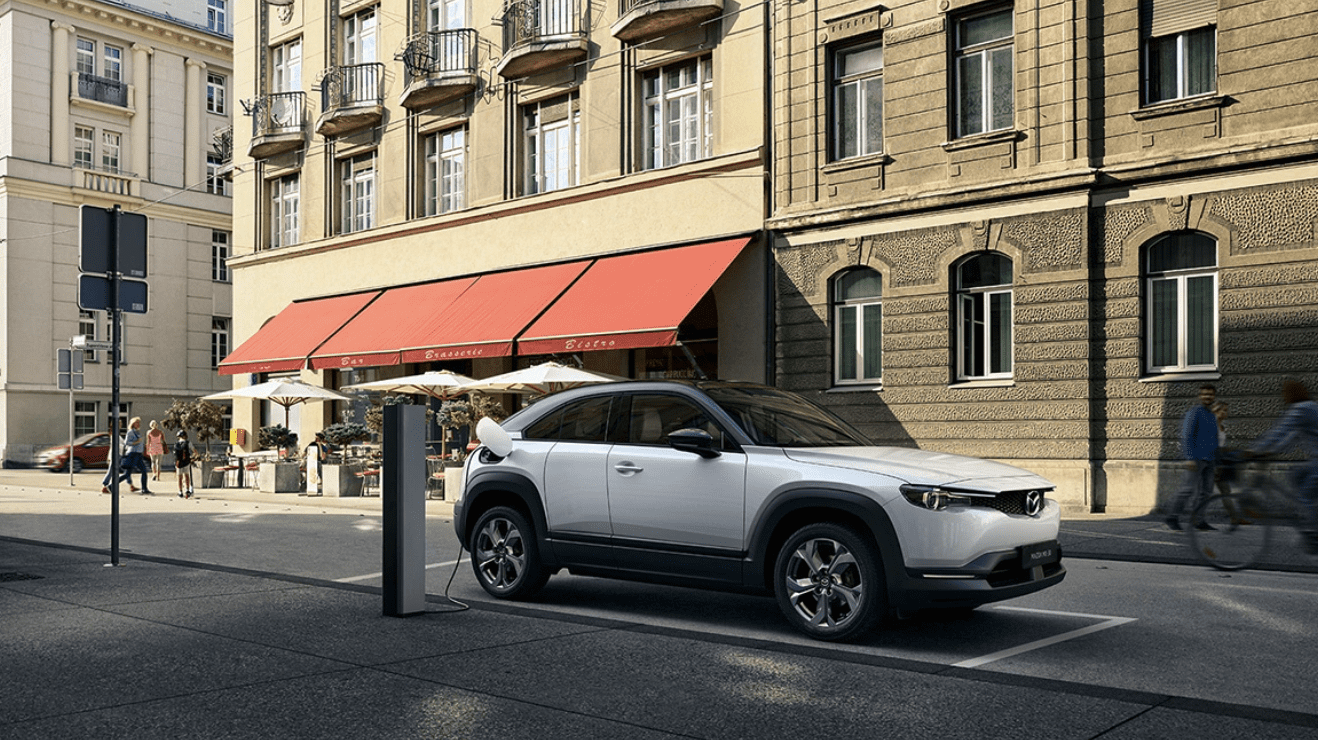
Photo Courtesy Mazda USA
Mazda MX-30: Mazda’s bespoke electric SUV is one of the most affordable EVs on the market. It starts with a base MSRP of $35,000 and qualifies for the $7,500 EV tax credit. The MX-30 is only available for purchase in California, and the company announced in July 2023 that it wouldn’t sell the car in the U.S. after the 2023 model year. The automaker will continue to sell the vehicle in Japan and Europe.
Its range is not as good as one would hope, only getting 100 miles before it needs to be charged. Charge time, though, is superb, reaching 80% battery in 36 minutes with DC charging. Mazda included a loyalty program with each purchase of the MX-30.
The Elite Access Loaner Program allows customers to access all Mazda models and drive them 10 days a year for three years. The exterior borrows from Mazda’s small-size ICE SUVs.

Photo Courtesy BMW Group
Mini Cooper: To combat a lack of affordable electric-powered convertibles, Mini has designed a new EV roadster. The Mini Cooper SE EV is emerging as one of the top cruising and leisure vehicles. The car took a full road trip across the East Coast, from Burlington, VT, to Greenville, SC, as part of its “Mini Takes the States” traveling showcase.
The vehicle body and detachable roof come from the Cooper S model, and the interior is made from sustainable materials.
Under the hood is the electric Cooper SE hatchback engine. It can go 0-to-60 in 7.7 seconds, which is pretty slow for a convertible cruiser, but it’s not expected to be a sticking point for customers. The Cooper SE EV has 143 miles of range in the battery.
Compared to competitors with similar EVs, the Mini is lighter and costs a fraction of brands like Porsche or Tesla. The price ranges from $29,000 to $30,000, which is not much different from the hardtop Cooper SE.

Photo Courtesy Nissan
Nissan LEAF: This is the “OG” of EVs. The LEAF was launched in 2009, long before electric cars were even a thought in the minds of car executives. When it went on sale in 2010, it boasted an impressive 125 miles of range, great for the time.
Now, batteries and range limits have improved substantially. That’s thanks to the LEAF. It opened the door for companies like Tesla, makers of a more efficient electric car. It was priced modestly at $32,780, which set a standard for the next generations of EVs.
The LEAF’s biggest contribution to the electric car movement was its charging stations. In Japan, the CHAdeMO network became essential to the LEAF’s long-term future in the country. As of December 2020, Nissan has expanded the network to 30,000 chargers globally, influencing Tesla and GM heavily.
Despite its small, modest appearance, the LEAF still sold 450,000 units by 2020 before the Tesla Model 3 dethroned it as the number one selling EV. The LEAF’s role in EV history cannot be understated.
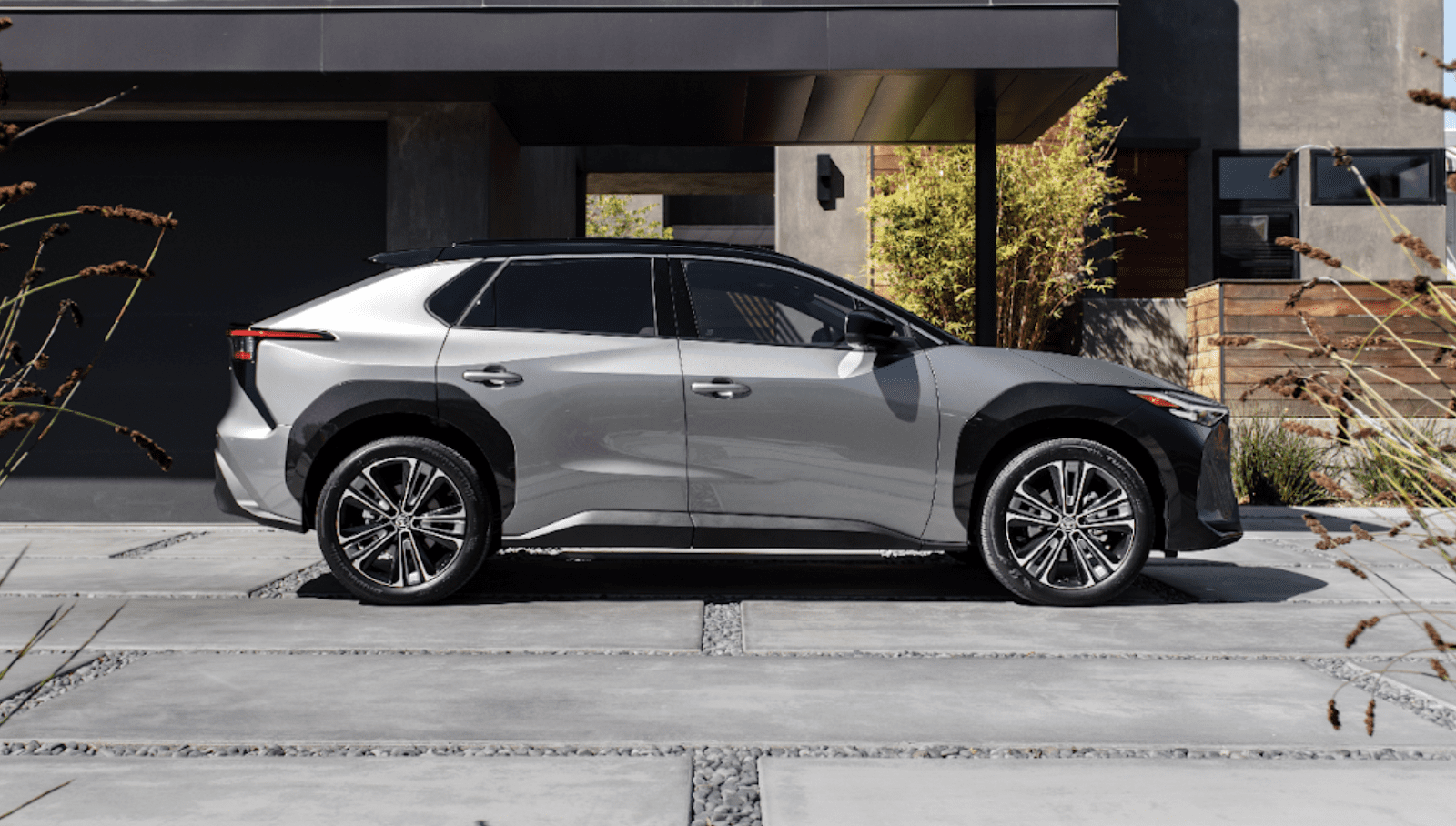
Photo Courtesy Toyota
Toyota bZ4X: The bZ4X is Toyota’s first mass-market EV, outside of the long-standing Prius lineup. It’s much different than its hybrid predecessors. The fully-electric crossover has 215 horsepower in the AWD version. The 0-to-60 time is 7 seconds, slower, but this car isn’t for racing.
Most reviews deem it’s for leisure driving. It gets you to where you need to be, thanks to its 252 miles of range.
The bZ4X also has regenerative braking. A fast charger can return 80% of power in less than an hour. Toyota will even give drivers a year of complimentary charging, thanks to its partnership with EVgo.
The interior is modest, with a basic infotainment system and a digital dashboard. There are 28 cubic feet of storage space in the trunk. Safety features include adaptive cruise control, lane-keeping technology, blind-spot monitoring, and safe exit assist. The base bZ4X costs $43,315 but qualifies for the $7,500 clean vehicle tax credit.

Photo Courtesy Vela Bikes
Vela Bikes: Vela creates high-tech e-bikes for bike riders in the city that feature an oversized seat tube that houses a cylindrical battery that can be removed. It makes it easier for bikers because they don’t have to take the whole thing inside their homes to charge.
A 350-watt motor powers the bikes and assists riders up to 20 miles per hour. The technology comes from an app, which includes Bluetooth, GPS, a 4G sim card, and a USB charging port.
The company, which moved its manufacturing from China to Detroit, offers two models. The Low Step is designed for riders 5’1” to 6 feet tall, and the High Step is made for riders 5’7” to 6’5”. The retail price for each bike is around $1,800.
Hauling And Municipal Transportation
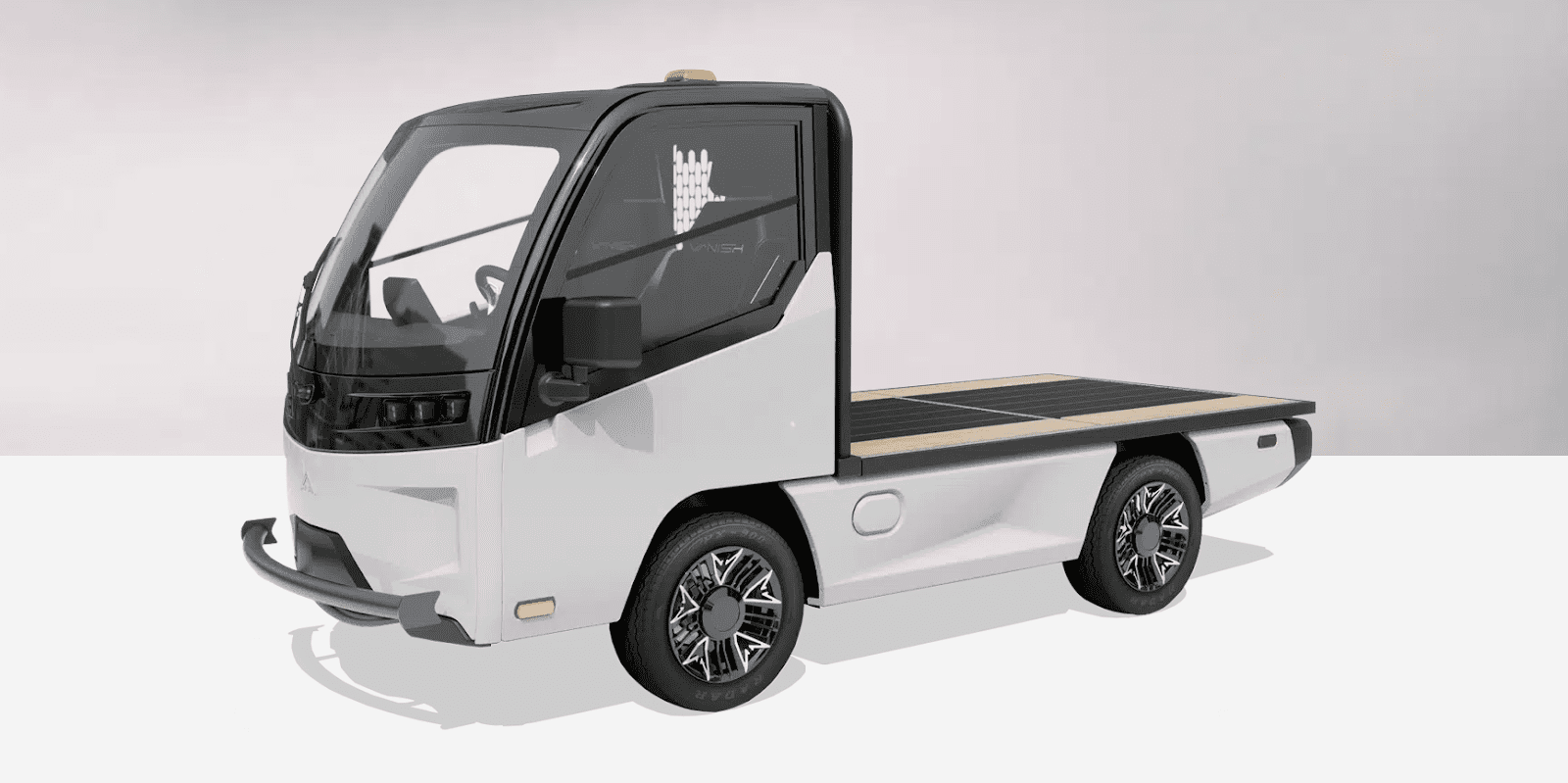
Photo Courtesy AYRO
AYRO Vanish: The Vanish is minimalist in design yet reliable and tough to take on the dirtiest jobs. It weighs around 3,000 pounds and carries up to 1,200 pounds in the flatbed. The small stature is perfect for navigating tight alleys and roads in cities.
Being a low-speed EV, don’t expect to get anywhere super fast. The Vanish only reaches 25 mph, and it takes about 6 seconds just to hit max speed. The range is not extensive, capping at around 50 miles. The bed can be changed from a flatbed to a pickup or van box with just a few tweaks.
The Vanish can only fit two people in the cab. The cabin has a heater and defroster, a Color Digital Instrument display, Bluetooth stereo with Apple CarPlay or Android Auto, air conditioning, and additional storage accessories.
In 2022, the company announced a dealer program allowing them to sell the Vanish and future AYRO products as fleet trucks for businesses, medical and college campuses, hotels, golf courses, marinas, stadiums, and municipal vehicles.
AYRO is currently taking pre-orders for the Vanish for $250 down. You can configure it to be street-legal or not street-legal, including doors — or not — and choose the bed. The MSRP is $33,900 before the IRA’s tax breaks.
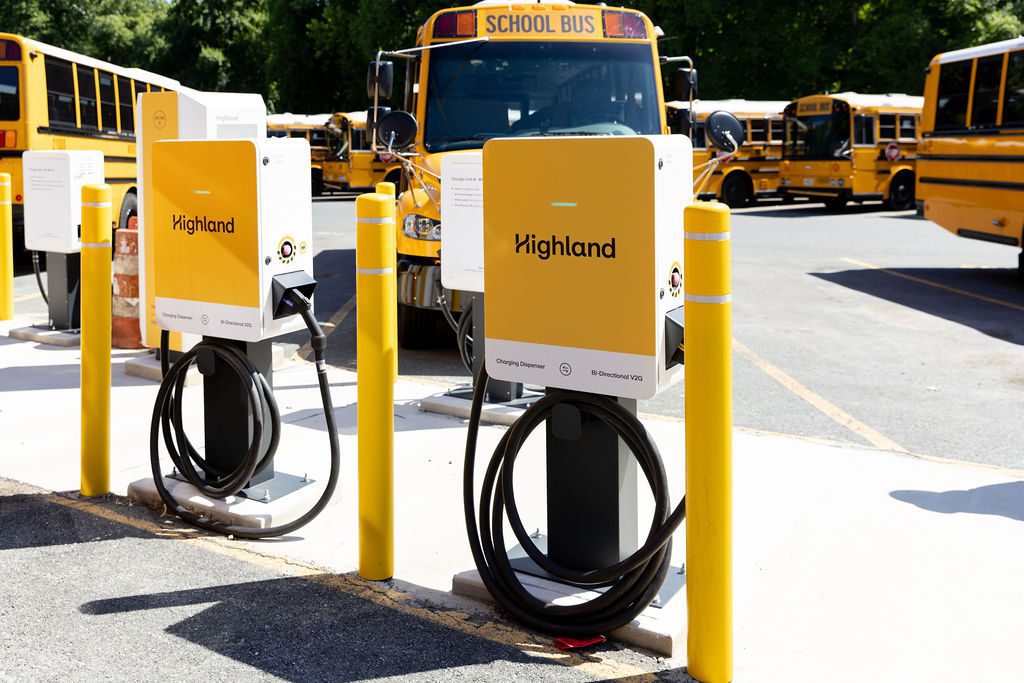
Photo Courtesy Highland Fleets
Thomas Built Buses: To combat emissions from school bus operations, Thomas Built Buses is developing a fleet of electric buses that will be deployed across the U.S.’s public schools. The Inflation Reduction Act has guaranteed electrification funding for bus fleets, being overseen by the Environmental Protection Agency. Around $2.5 billion was allocated to build zero-emission buses.
Thomas Built electric buses have bidirectional capabilities, which can help power the grid. The Highland Electric Fleet line activated these buses with their electrification services. Highland’s V2G technology can power 600 homes and deliver 80 hours of power in some regions.
This function was on display in Beverly, MA, where the first Highland buses were driven. Since school buses are only used sparingly throughout the day, they can function as a power supply when idle. More buses like this are expected to become available as V2G technology expands.
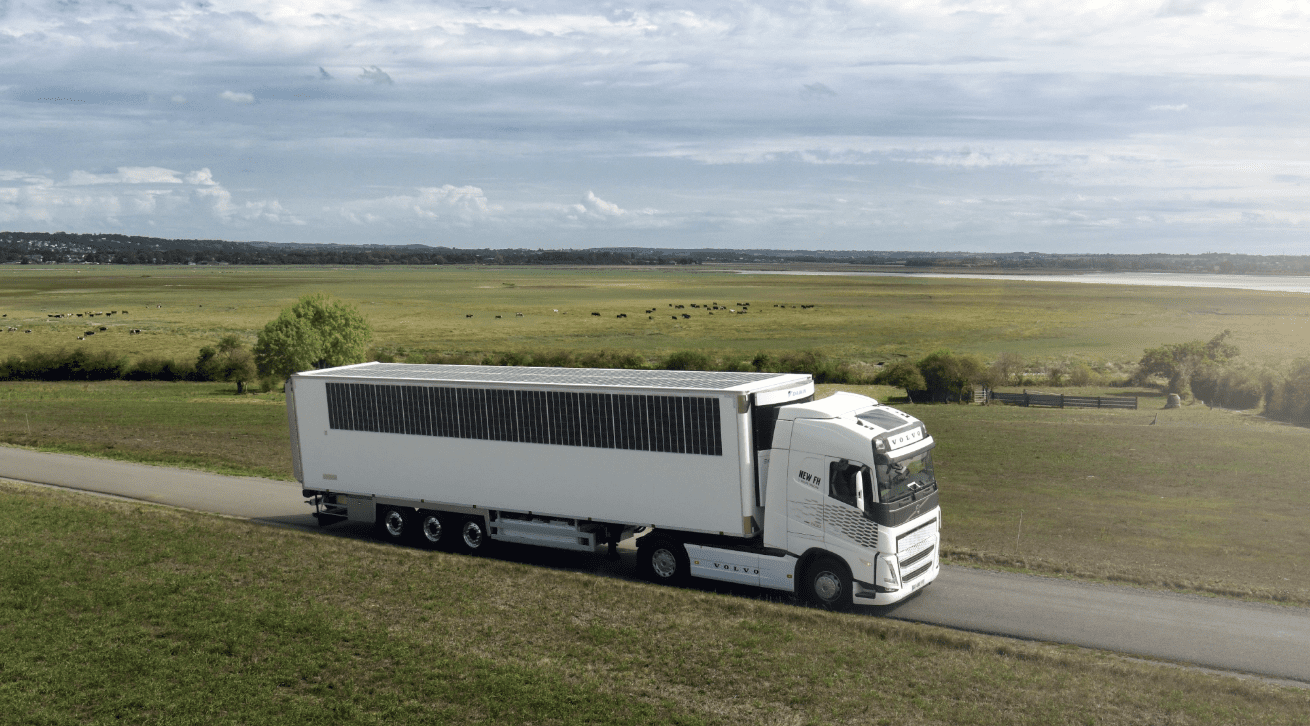
Photo Courtesy Sono Motors
Sono Solar-Paneled Trucks: German EV startup Sono Motors developed a car with solar tech installed on the roof to reduce stationary charging. It’s a more sustainable way to keep vehicles on the road, putting less strain on a country’s electrical grid. Now, the technology heads to freight trucks.
Unveiled at the IAA Transportation show in Germany, Sono showcased several semis, trailers, and buses fitted with solar panels.
While diesel fuel is still required in some capacity, solar energy powers things like climate control and infotainment interfaces. The company says these buses can save 396 gallons of diesel per bus/truck.
It tested the trailers on refrigeration trucks, and the panels covered 50% of the refrigeration power. Sono retrofitted a Mercedes Ciantro and MAN Lion City Bus with the panels to test them on civilian transports. It found this could save 1,500 liters of diesel each year and reduce carbon dioxide emissions by 4 tons.
Some other companies, like Worksport in Canada, want to add solar panels to its tonneau attachment for pickup trucks, showing that many companies see Sono’s developments as the way of the future.






